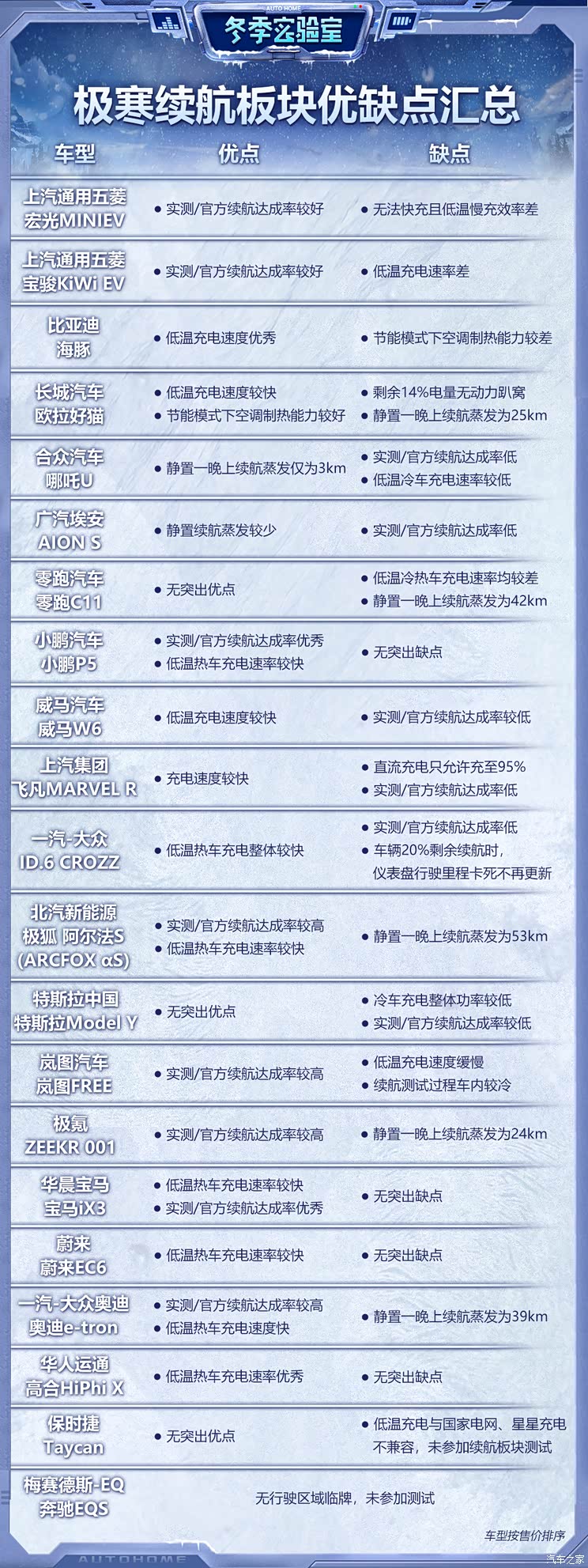The first phase of dry goods conclusion sees the whole, winter laboratory test analysis
[Autohome] New energy] All the test results of the 2021 Autohome Winter Lab have been announced. I believe that after watching all the test videos, you also hope to see the key data conclusions and product problems refined and analyzed. So far, the test team has sorted out the results of the 21 models and extracted representative problems for analysis. There are many results that exceed expectations, but there are also unexpected ones. I hope the conclusions in this issue will help us buy cars and drive safely in winter.
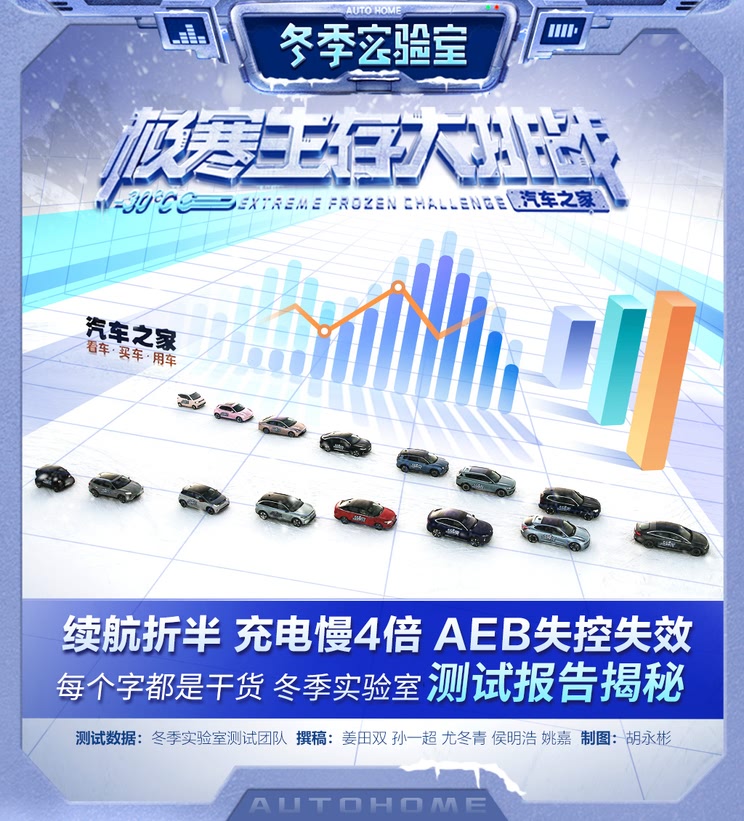
You will see the following dry goods conclusions in this issue. If you need to jump to more content, please click the link at the back:
● Test battery life has shrunk by nearly half! Teach you to plan a winter travel radius (click to jump)
● Low temperature charging time is 4 times slower, lithium iron phosphate is still afraid of cold? (click to jump)
● Extreme cold standing, overnight battery life actually evaporated 7%? What’s the problem? (click to jump)
● PTC or heat pump? Correct usage of battery life "killer" air conditioner (click to jump)
● Smart cars are frozen stupid when they are cold. Which functions are seriously hindering them? (Click to jump)
Danger! Driving knowledge that must be paid attention to on ice and snow roads (click to jump)
● A quick overview of the advantages and disadvantages of the 21 models of the Winter Lab (click to jump)
The 2021 Autohome Winter Lab completed the evaluation of all projects in late December. The 21 annual popular pure electric vehicles were launched in Shenyang, Changchun, and Baishan cities in Northeast China, completing 15 sub-projects in the three major sectors of extreme cold battery life, car use, and driving control. The model selection covers the sales popularity of models in 2021 by brand, and the brand’s latest technology platform or latest model should be selected as much as possible.
All the test items in this winter laboratory are derived from real users’ winter car use scenarios. The final objective data and conclusions generated are analyzed for the convenience and safety of users’ cars, and objectively present the true performance of pure electric vehicles in extremely cold environments. Therefore, the test results of this winter laboratory only represent the performance of the vehicle in this extremely cold environment, which can be compared with the normal temperature link, but it is not recommended as a key reference for the overall product strength of the model.
● Each is a pain point topic! Tests are based on real user surveys
Before formulating this year’s winter laboratory test project, we conducted a variety of data surveys on the real car needs of pure electric vehicle users, so that all test projects were derived from real car scenarios. After Autohome’s continuous attention to consumer car purchase demand in the past two years, we found that users’ requirements for pure electric vehicle cruising range are still on the rise. In the acceptable actual cruising range survey, consumers who expect cruising range of 800 kilometers and 1000 kilometers will increase in 2021 compared with 2020, but consumers who demand 350-500 kilometers will decrease.
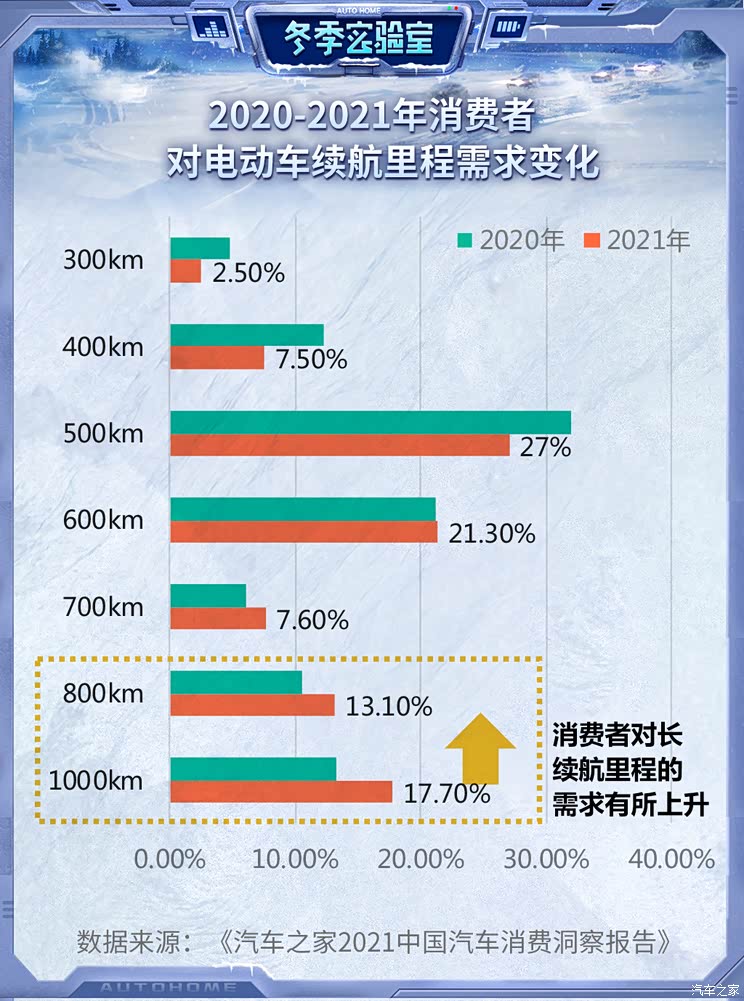
From this perspective, the cruising range is still a major pain point for electric vehicle users at this stage. And as the temperature decreases, people’s attention to the cruising range will continue to increase. In our online poll "What is your most wanted electric vehicle winter challenge project", more than half of the people still ranked the actual cruising performance as their top concern.
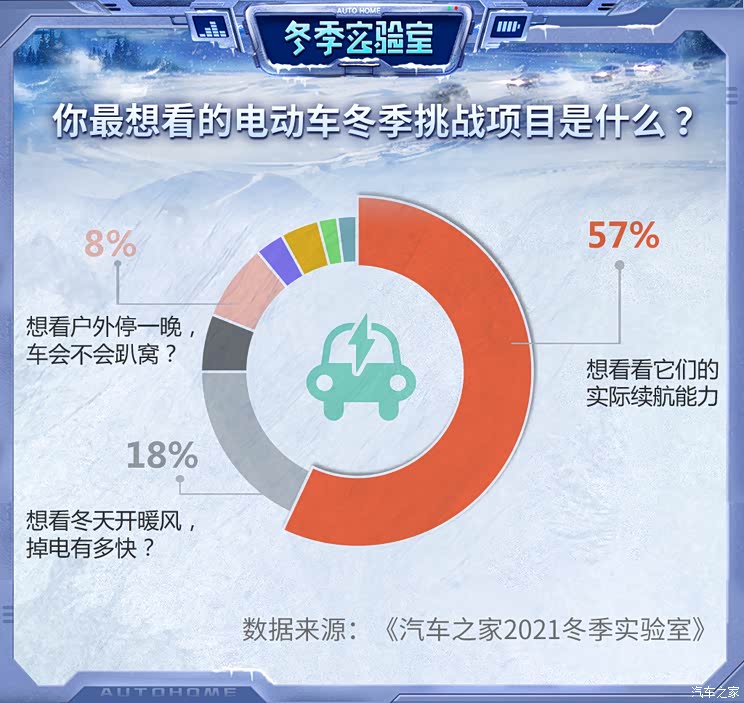
In addition to the range, consumers now have corresponding high requirements for charging time. Limited by the inconvenience of home charging in first- and second-tier cities, most people can best accept the layout of charging facilities within 2 kilometers in terms of charging facilities. In terms of charging time, 44.4% of consumers accept 30-45 minutes of fast charging to supplement power, while 2-4 hours is the acceptable charging time for most consumers in the slow charging state. Therefore, this winter laboratory, the test team still focuses on the low-temperature comprehensive battery life test and charging test.
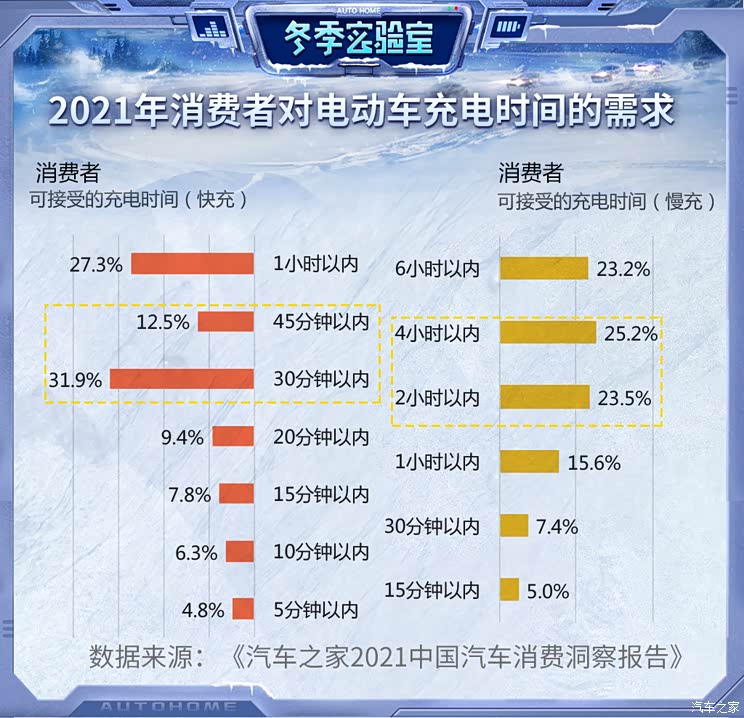
If the performance of a vehicle’s battery life, charging, and driving control represents the hardware level of the product in terms of the three-power system and vehicle adjustment, then the functions such as intelligent cockpit and active safety represent the performance of the product in terms of soft power. Especially with the popularity of smart cars, a large number of electronic devices, software functions, and voice interaction in the car have gradually become standard. According to the Autohome survey results, 5-6% of users are concerned about the configuration of intelligent networking.
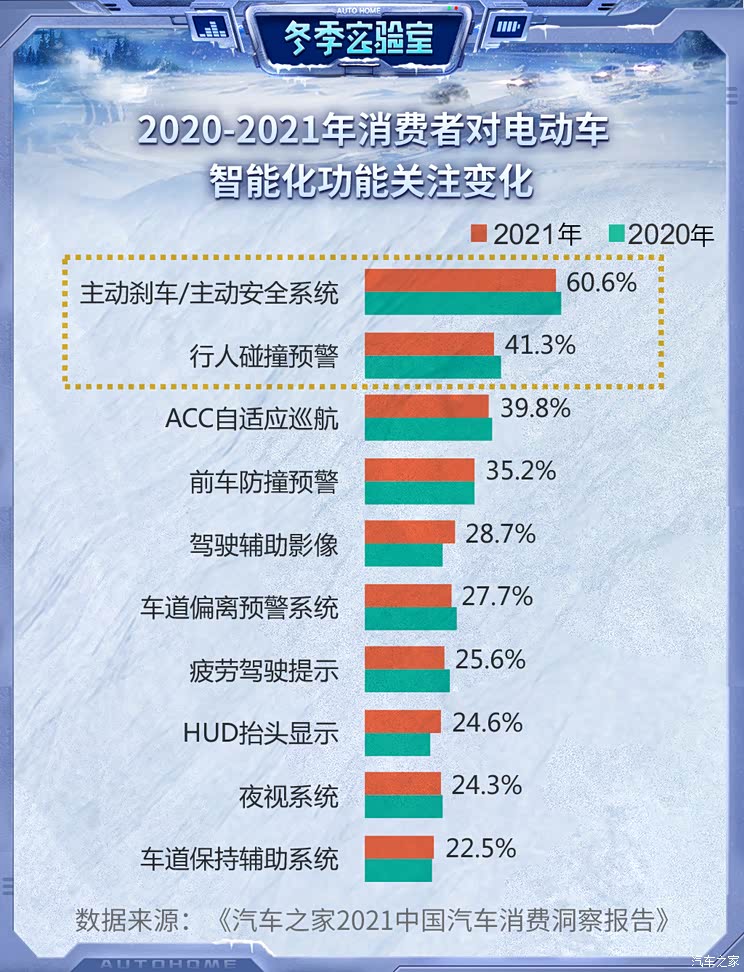
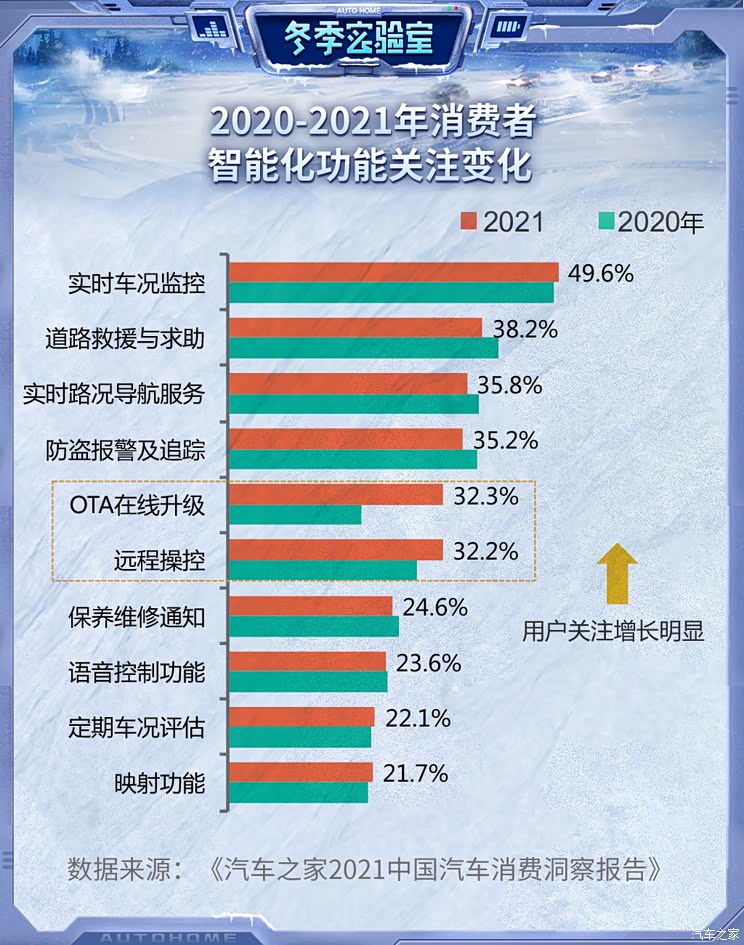
因此,相比于往年冬季实验室,今年项目组重新根据真实的用户需求,策划了“极寒用车测试”和“极寒驾控测试”两个板块,更多项目的延伸,也产出了更多真实有效的用车结论。在接下来的内容中,我们也将逐项将测试中发现的问题以及干货用车知识,进行详细分析。
● 低温仍然是续航第一杀手
电动车怕冷的问题已经老生常谈,每年冬季实验室的续航测试板块都是话题聚焦的部分。其实多数电动车车主买车后只要经历过一个冬天,都会对车辆的低温续航能力有个大概的认识。但对于没有使用经验的准车主,或者电动车的围观群众来说,“电动车冬天到底能开多远”一直是困扰大家的玄学命题。所以这次我们在东北-20℃至-30℃极寒环境、高速路段比例过半的极限条件下,摸清电动车冬季续航的下限,并在其中发现车辆的问题,将对您的出行规划有很大的参考价值。
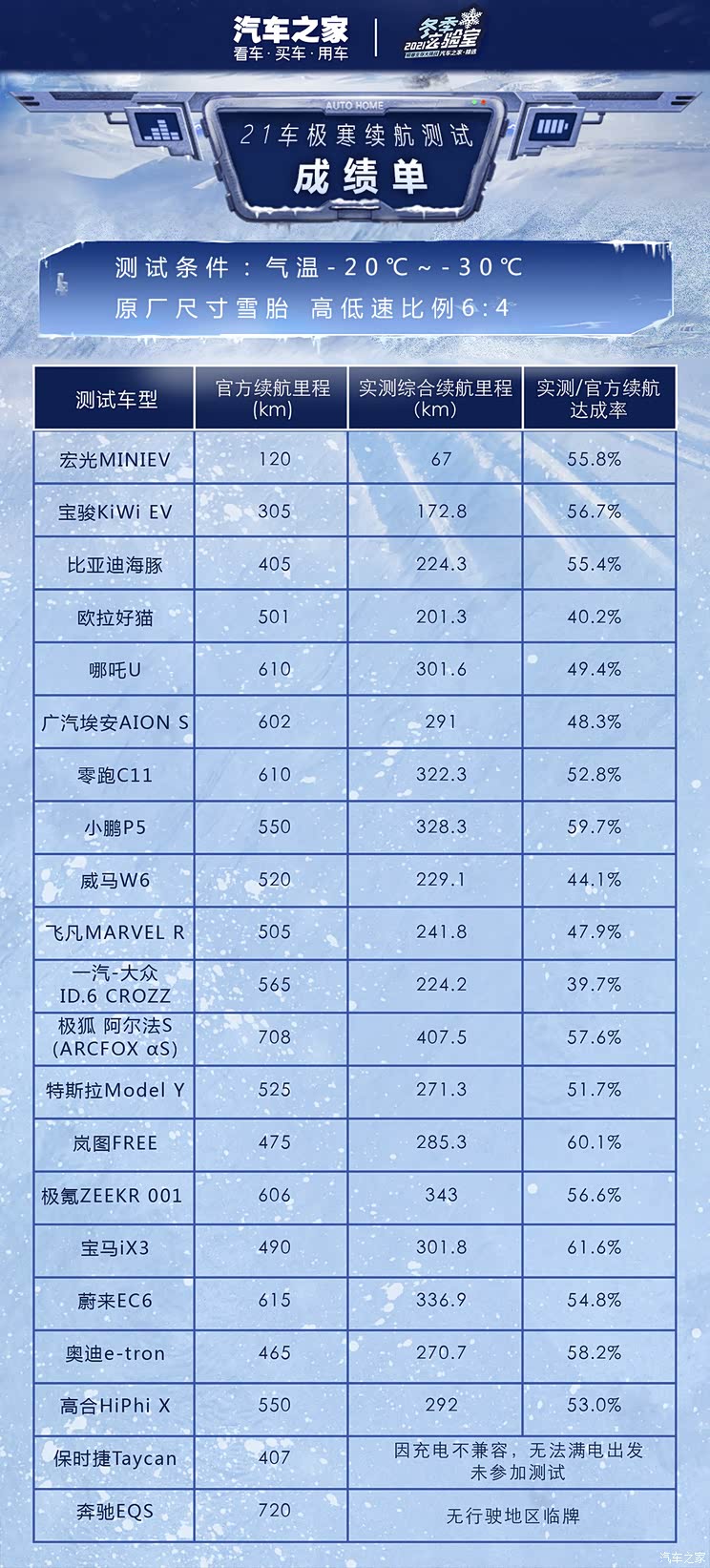
此次低温综合续航测试中,除保时捷Taycan因充电不兼容、奔驰EQS无当地行驶临牌外,参与测试的其余19台车的平均官方续航超过了510km,而最终实测成绩相比官方续航的平均达成率仅为52.5%,且多台车型的实测续航里程低于五折。对比往年冬季实验室在河北崇礼-10℃至-15℃环境约68%达成率的测试数据,可见气温进一步降低到-20℃至-30℃的极寒环境,对电动车综合续航有更加严重的影响。
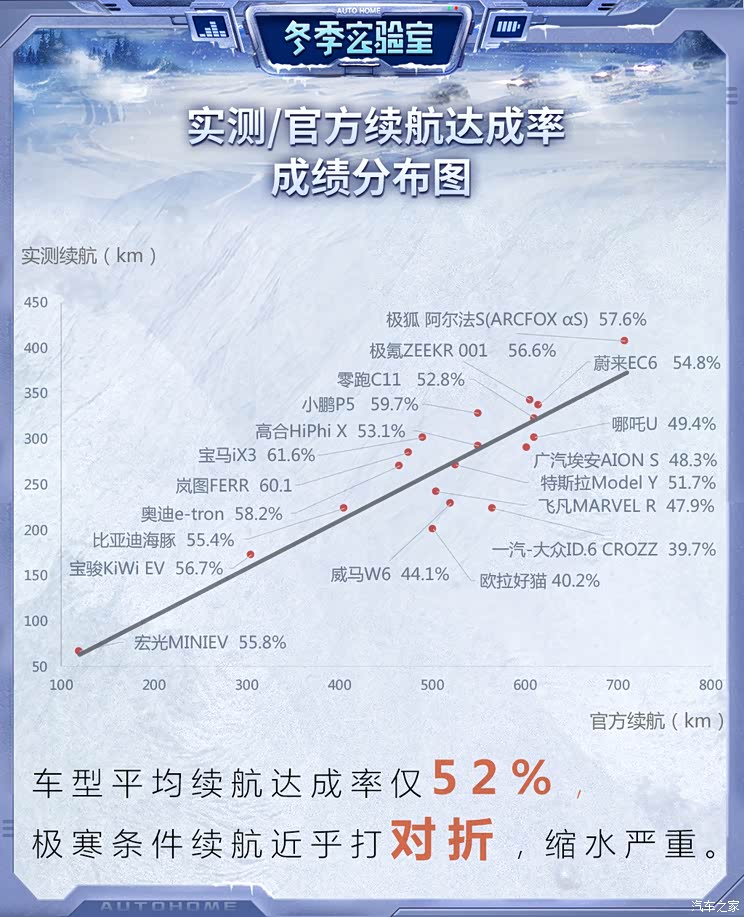
图表中【直线】上方的车型,表示实测续航达成率优于此次测试的平均水平,线下方的车型则表现不佳。如您的爱车不在此次测试中,也可以参照52%的平均达成率来估算您车辆在冬季续航的下限。需要特别声明的是,为了测试安全以及还原真实用户场景,所有车辆均更换了原厂尺寸的雪胎,轮胎滚阻的增加也对续航成绩有一定的影响。
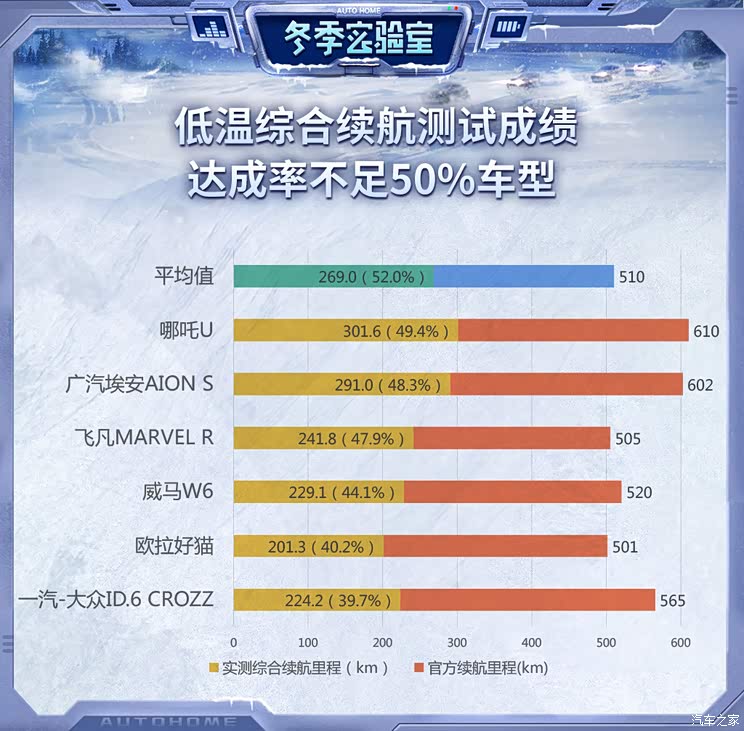
哪吒U、广汽埃安AION S、飞凡MARVEL R、威马W6、欧拉好猫和一汽-大众ID.6 CROZZ这六款车型的实测/官方续航达成率均不足50%,成绩最差的一汽-大众ID.6 CROZZ实测综合续航仅有224.2km,约占官方续航的39.7%,续航缩水最为严重。
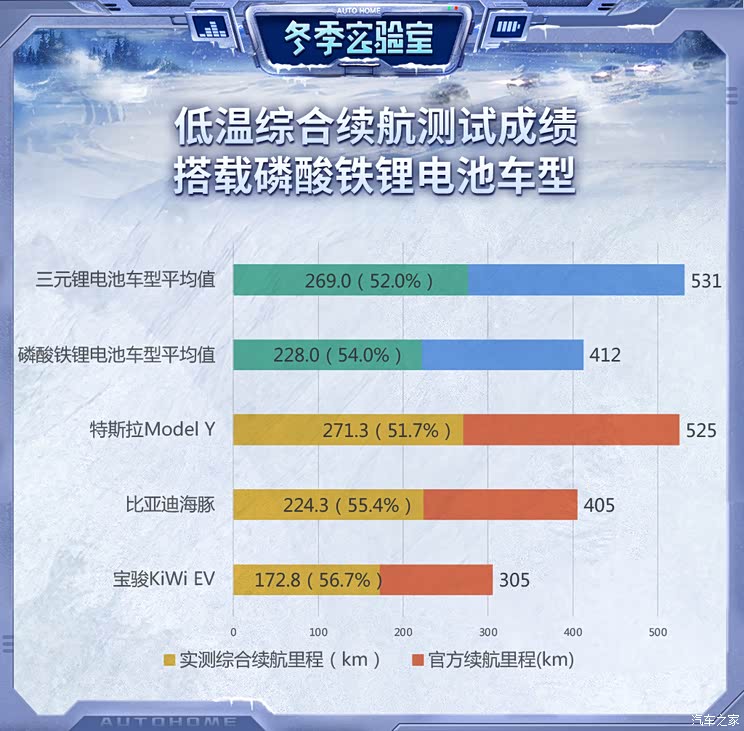
而三款搭载磷酸铁锂电池的车型,仅有特斯拉Model Y 51.7%的实测/官方续航达成率略低于整体平均水平,宝骏KiWi EV、比亚迪海豚的达成率都超过了55%,三款车型的平均表现甚至高于搭载三元锂电池的车型。可见在极寒环境,拥有热管理系统的加持,磷酸铁锂电池同样能提供比较理想的续航,表现高于预期。
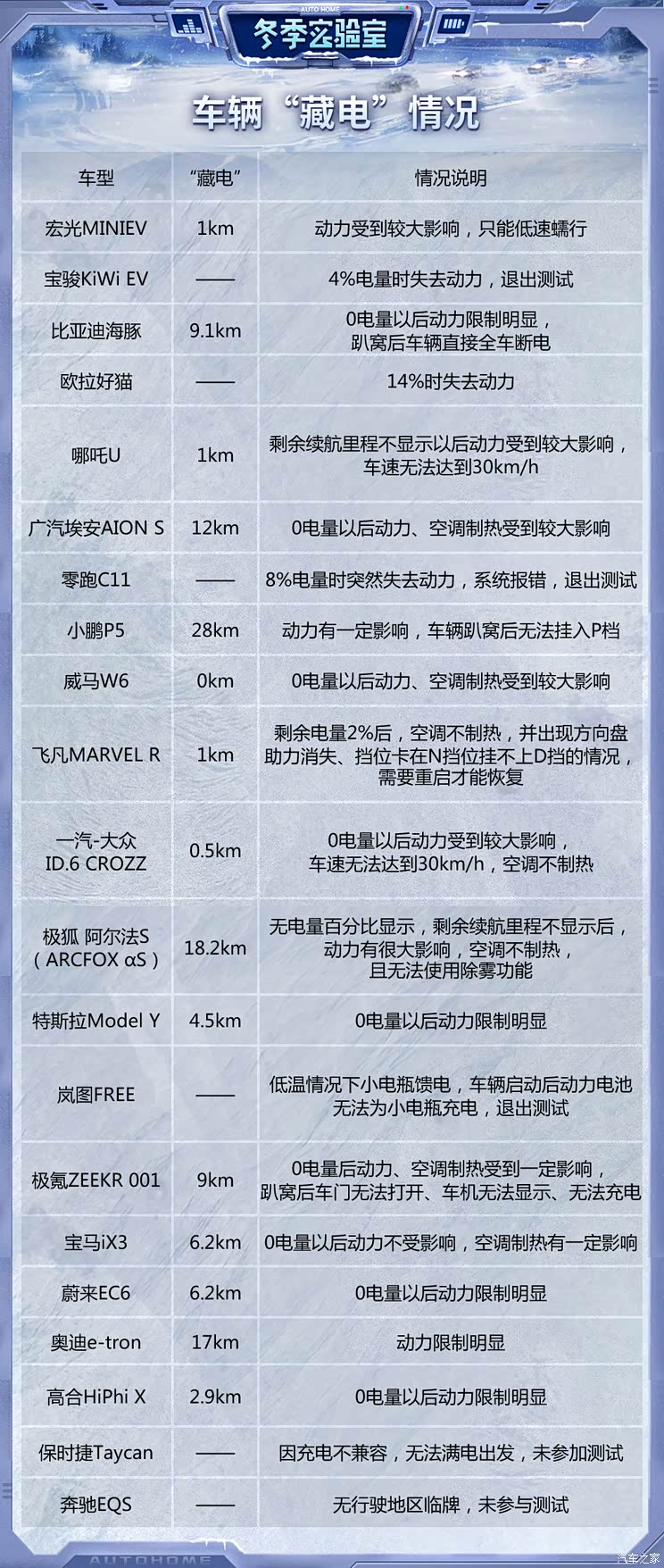
此外根据测试结果我们发现,车辆在不再显示剩余续航里程或0电量状态下,仍可行驶的里程不足10km,同时会伴随动力明显受限的情况。续航跑干仅为您提供相关数据的参考,但我们强烈建议您用车时,不要在低电量行驶,当车辆续航低于20%时请务必规划和前往充电。
● 低温进一步暴露车辆稳定性问题
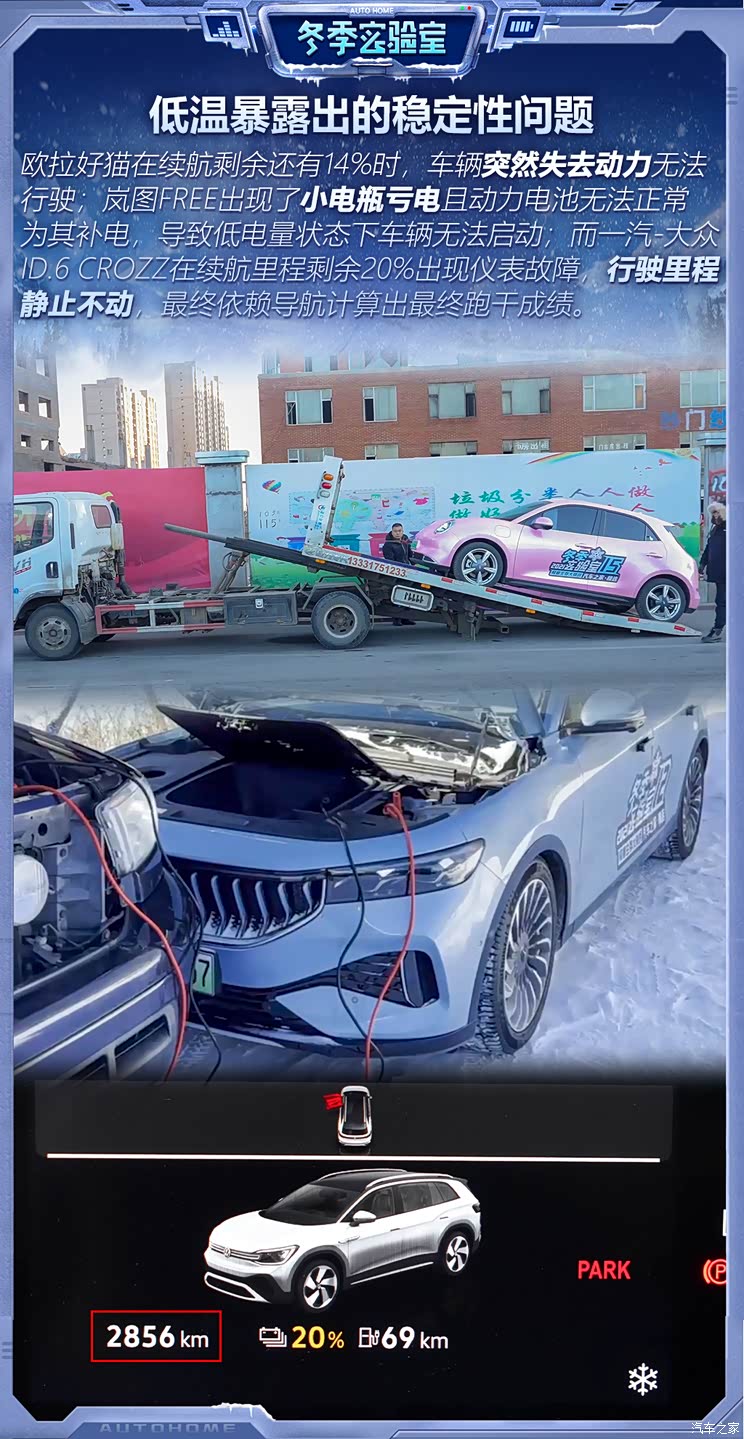
测试中的低温环境,也对电池的放电逻辑、车机硬件提出了较大的考验,进一步暴露了低电量时车辆的稳定性问题。例如欧拉好猫在续航剩余还有14%时,车辆突然失去动力无法行驶;岚图FREE则出现了小电瓶亏电且动力电池无法正常为其补电,导致低电量状态出现车辆无法启动;而一汽-大众ID.6 CROZZ在续航里程剩余20%出现仪表故障,行驶里程出现静止不动的情况,最终依赖导航计算出最终跑干成绩。相比续航的缩水,车辆稳定性问题对用户用车的影响更加严重,如果连行驶这一本职工作都无法正常完成,无疑会让用户对电动车丧失信心。
● 低温进一步缩减出行半径
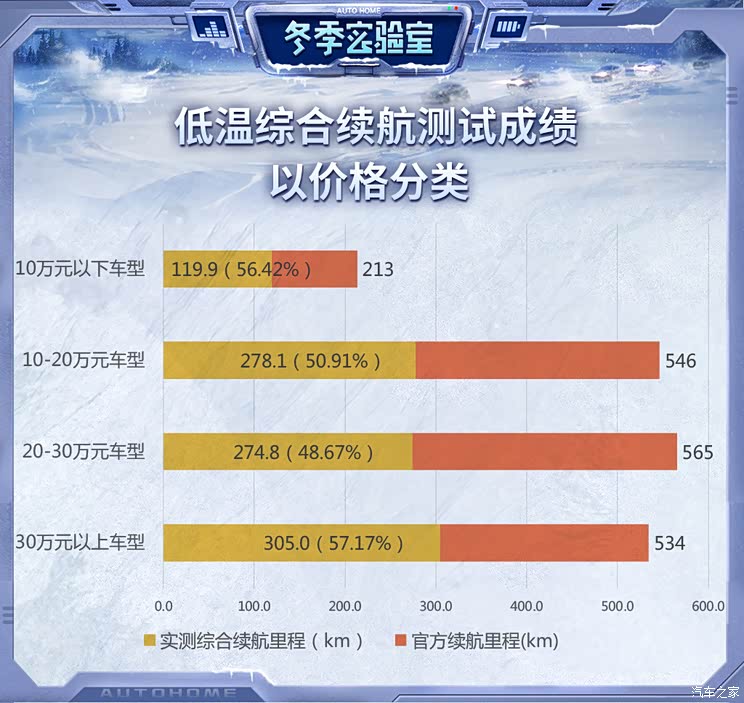
极寒温度、雪胎以及统一的车辆设置模式,让此次冬季实验室低温续航测试条件严苛且标准化,因此车辆成绩仅为大家提供了一个可以参考的下限。如果您在日常用车中没有这么高比例的高速路段、气温更加友好,实际可用的续航也会优于52%的测试成绩。参考不同价位车型的平均实测综合续航里程,已经可以满足大多数用户的市内通勤需求,只要做好出行规划、勤充电,在北方城市开电动车也能温暖过冬。
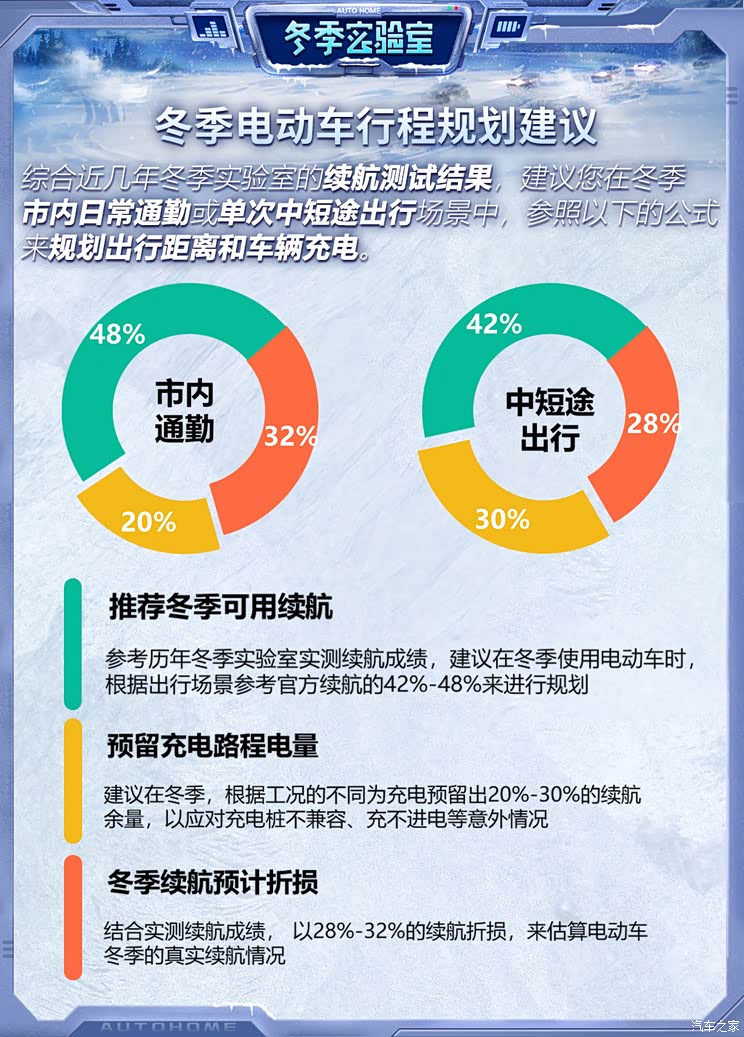
根据本次综合实测成绩,并结合此前几年冬季实验室的测试结果,我们拟化了一个合理评估电动车在冬季出行半径的公式。结合该公式,例如您在冬季市内日常通勤时,两次充电间的行程可参考车辆官方续航的48%来进行规划,并为充电预留出20%的续航余量,以避免在低温+低电量条件下出行时趴窝在路上。如果是中短途出行,建议出行的距离为官方续航的42%,并留出30%的续航以应对充电桩不兼容、充不进电等意外情况。
低温充电时间慢4倍,磷酸铁锂依旧怕冷?
和续航一样备受关注的还有电动车在低温环境下的充电问题,低温造成的锂电池活性下降不仅对续航有影响,充电的效率同样也会严重衰减。尤其是将车辆在室外静置一夜后再进行冷车充电,-10℃左右的电池会对充电的速度、兼容性造成更大的挑战。
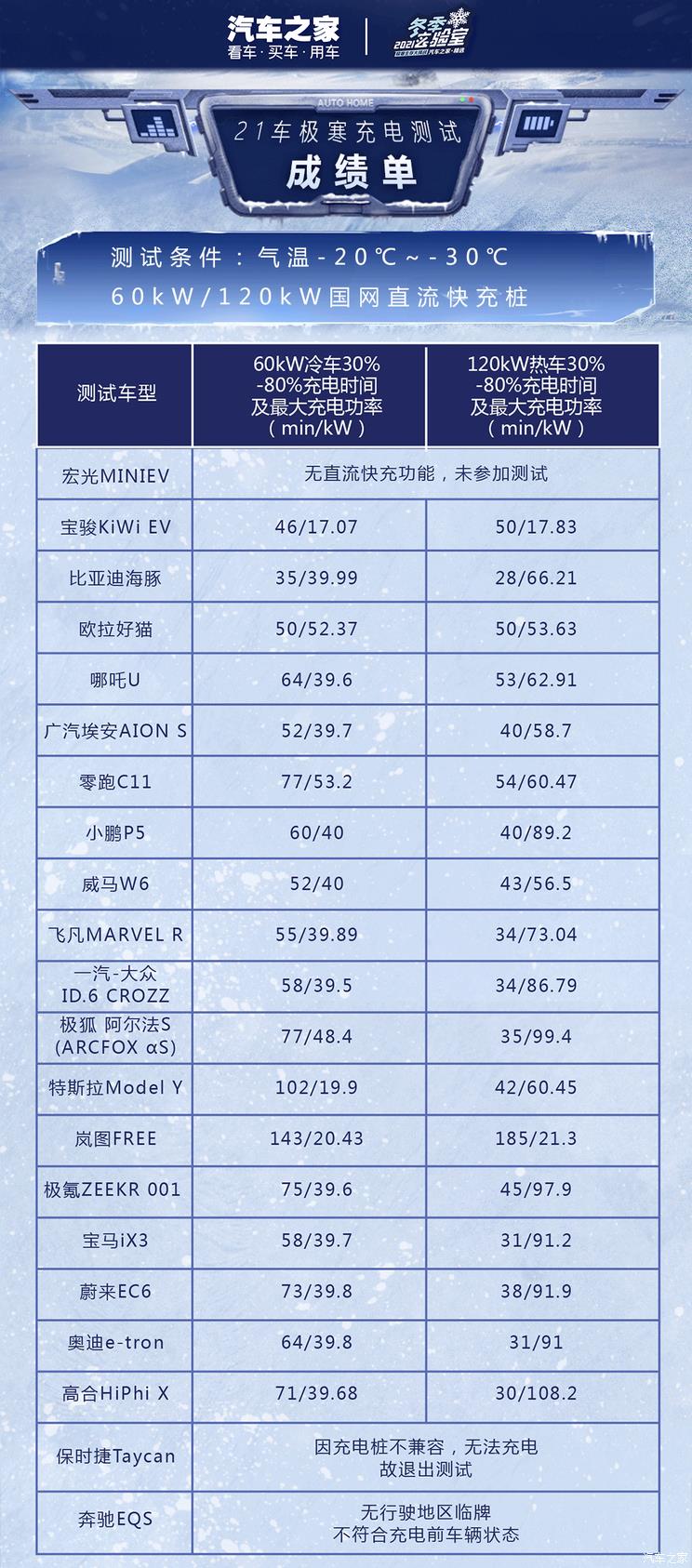
因此在今年的充电测试中,我们分别测试了冷车(静置后)和热车(行驶后)充电,同时也加入了60kW和120kW充电桩峰值功率的对比。结果发现,极寒环境会让车辆暴露出严重的充电兼容和功率低下的问题。
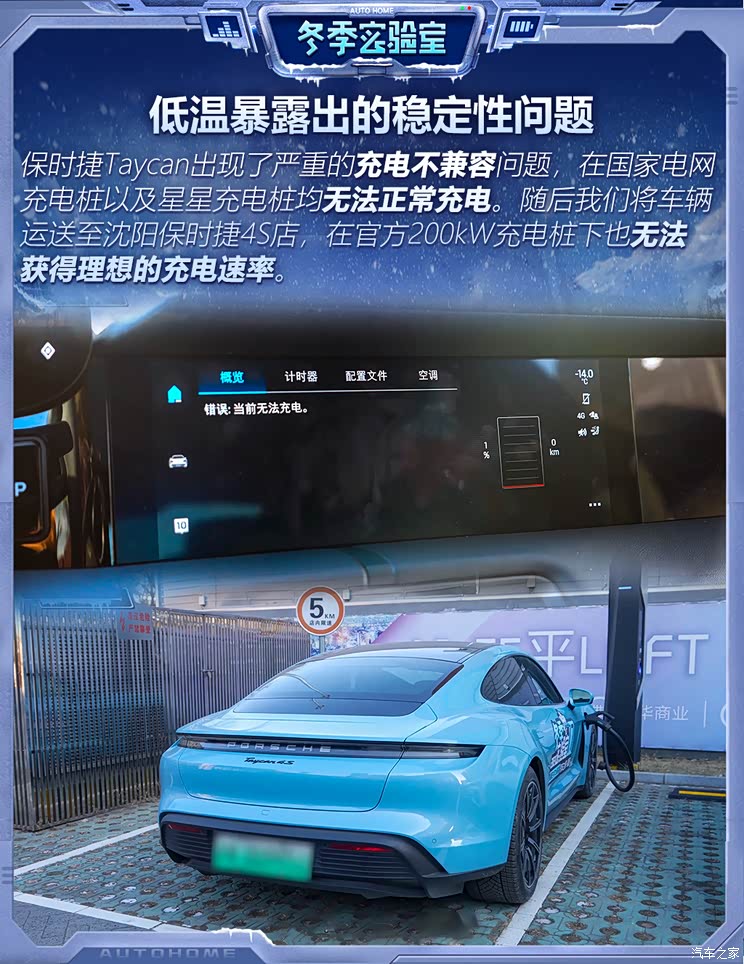
在冷车充电测试中,保时捷Taycan出现了严重的充电不兼容问题,在国家电网充电桩以及星星充电桩均无法正常充电。随后我们将车辆运送至沈阳保时捷4S店,在官方200kW充电桩下也无法获得理想的充电速率。充不进电,无疑给电动车的冬季出行判了“死刑”。而在上一季的冬季实验室中,参与测试的保时捷Taycan表现非常正常,此次暴露的问题也大大出乎了我们的预料。品牌方表示,这可能是因为低温环境下,电池管理系统对电池大功率充电进行了限制。
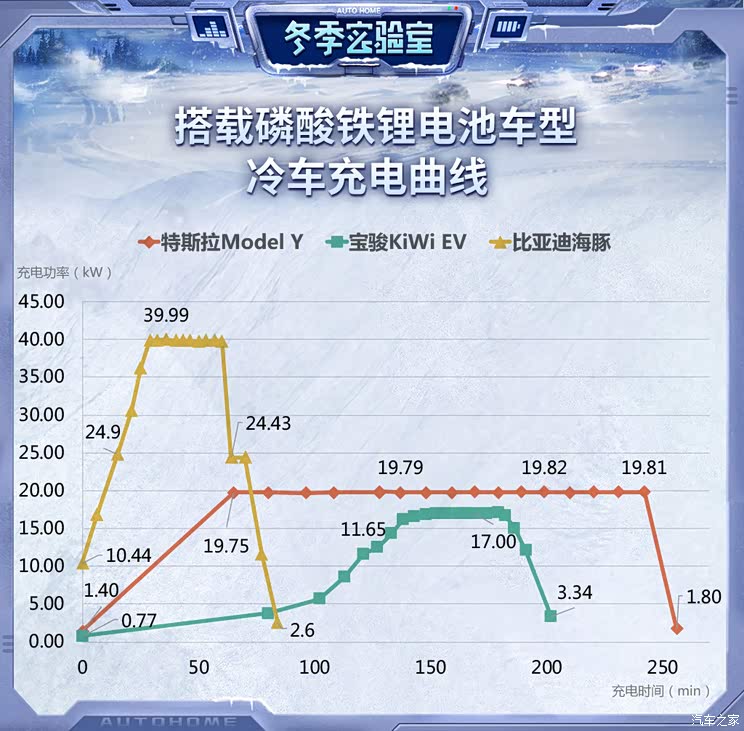
测试中我们还发现,搭载磷酸铁锂电池的车型在低温静置后,充电环节对电池温控系统的依赖明显更高,特斯拉Model Y和宝骏KiWi EV都出现了冷车充电起始时持续低电流的情况。在启动充电的前1个小时两台车均处于持续电池加热阶段,之后充电电流才有所上升,最终分别以19.9kW、17.1kW的最大充电功率完成冷车测试,处于测试成绩中垫底的位置。
而同样采用磷酸铁锂电池的比亚迪海豚,其加温逻辑是在刚插入充电枪且尚未完成充电连接时,就开启电池温控系统,以约5kW的功率为电池加热,以更快速度获得合理的充电功率。虽然有电池包容量较小的因素在内,其充电时长仍是所有测试车型中的最快成绩。但海豚的加热逻辑如果遇到电量较低、充电桩又存在兼容性问题的极端情况,加温过程可能会造成额外电量的浪费。
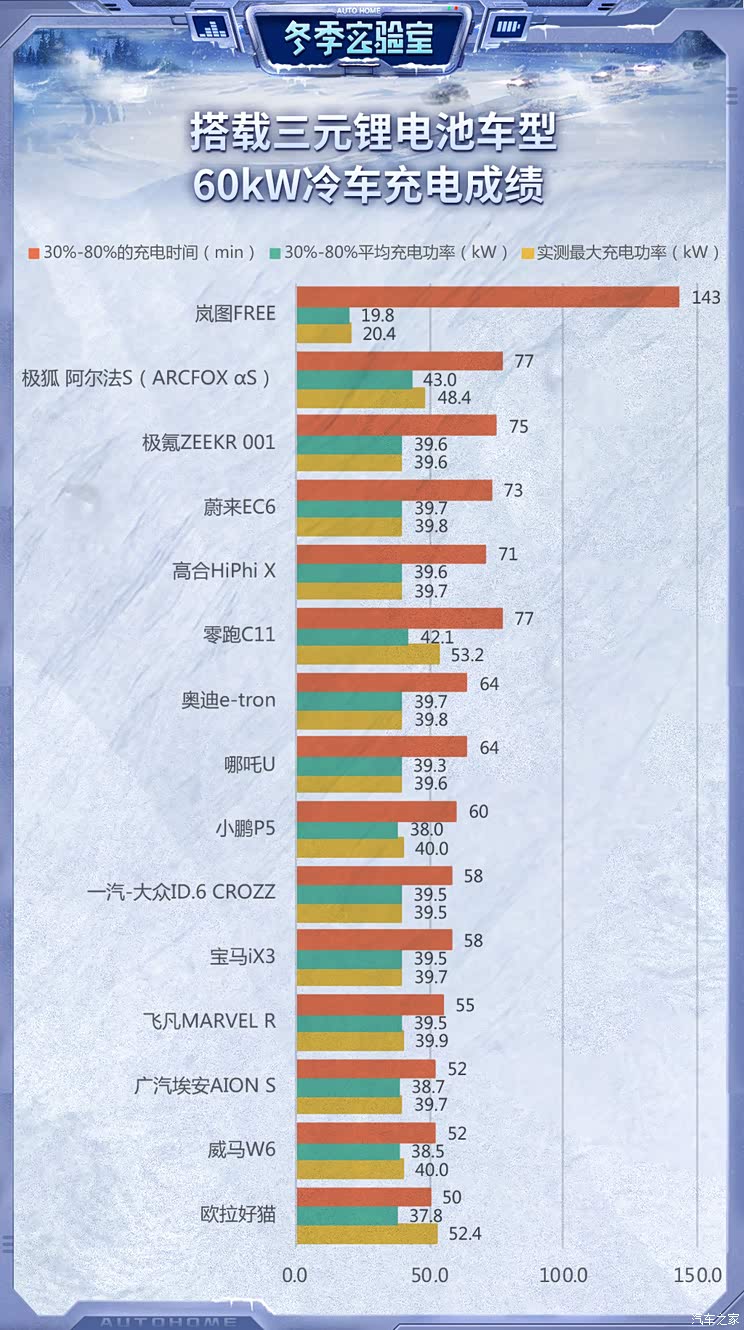
搭载三元锂电池的车型在测试中整体表现稳定,在60kW充电桩下,冷车充电30分钟后即可接近最大充电功率,平均完成30%-80%充电的用时为68.6分钟,其中欧拉好猫、广汽埃安AION S、飞凡MARVEL R、威马W6、一汽-大众ID.6 CROZZ、宝马iX3的测试成绩表现更好,充电过程中的平均功率均接近40kW。
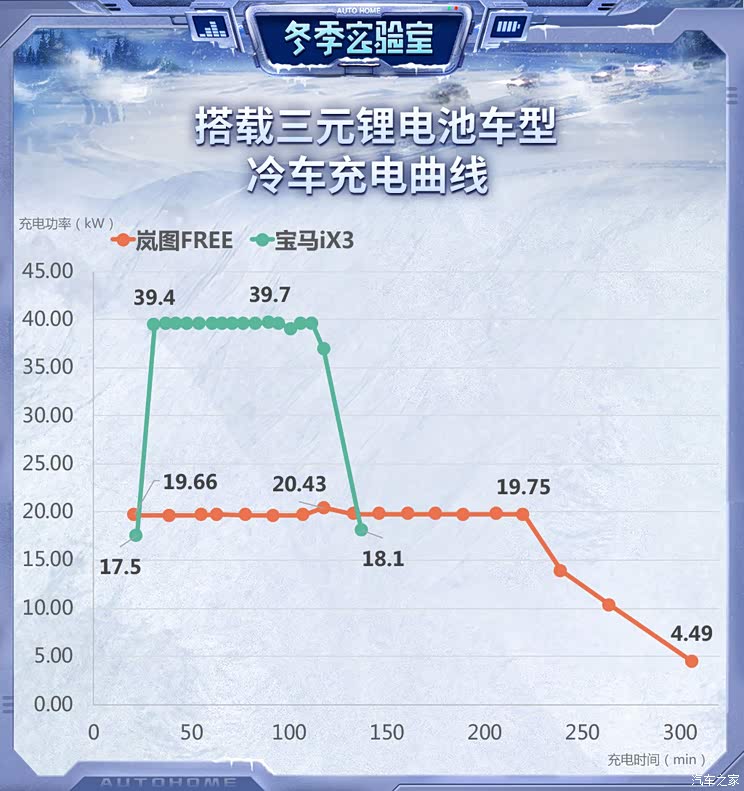
而岚图FREE的充电功率仅20.43kW,在三元锂电池车型中排名倒数第一,30%-80%充电时间在所有车型中垫底。充电过程中,车辆的需求电流始终处于较低的数值,在之后的120kW热车充电测试中又再次复现了这一问题。可见车辆在低温条件下的电控逻辑非常保守,过慢的充电过程会严重影响用户冬季出行时的用车信心。
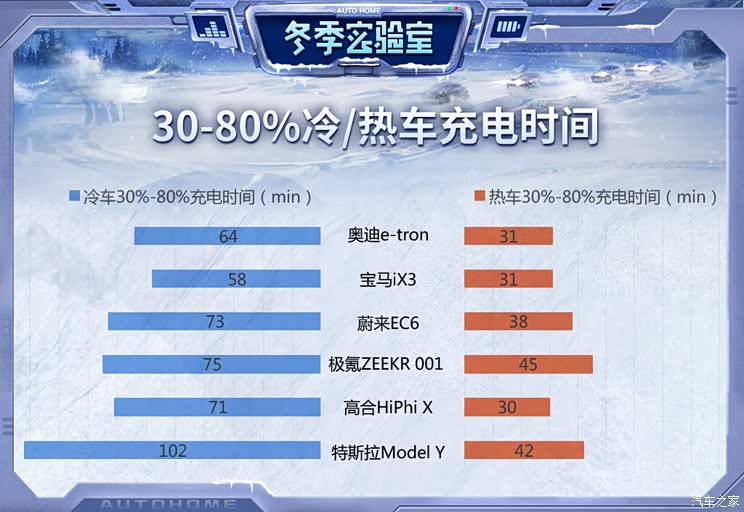
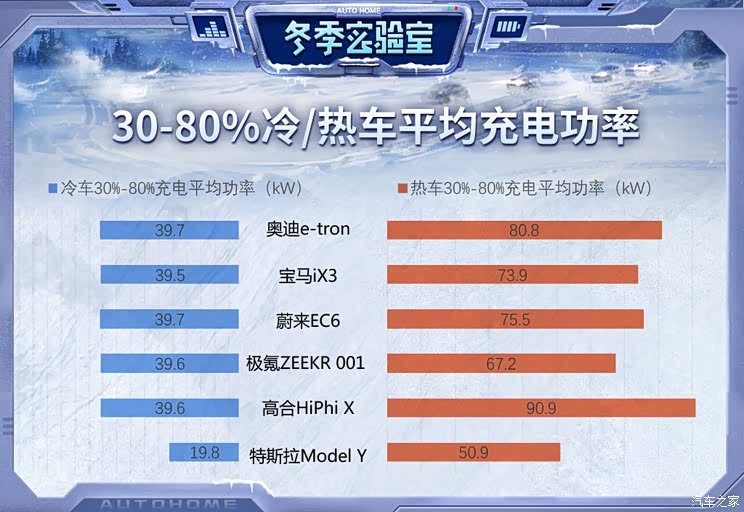
热车充电测试中,所有车辆统一在中低速状态下行驶一段时间后,立刻在国家电网120kW充电桩充电,以贴合用户的实际充电场景。结果显示,热车状态下车辆的充电功率提升更快,同时对比冷车充电使用的60kW充电桩,多数车辆可以在120kW充电桩下获得更高甚至翻倍的峰值充电功率,充电时间也相应缩短。
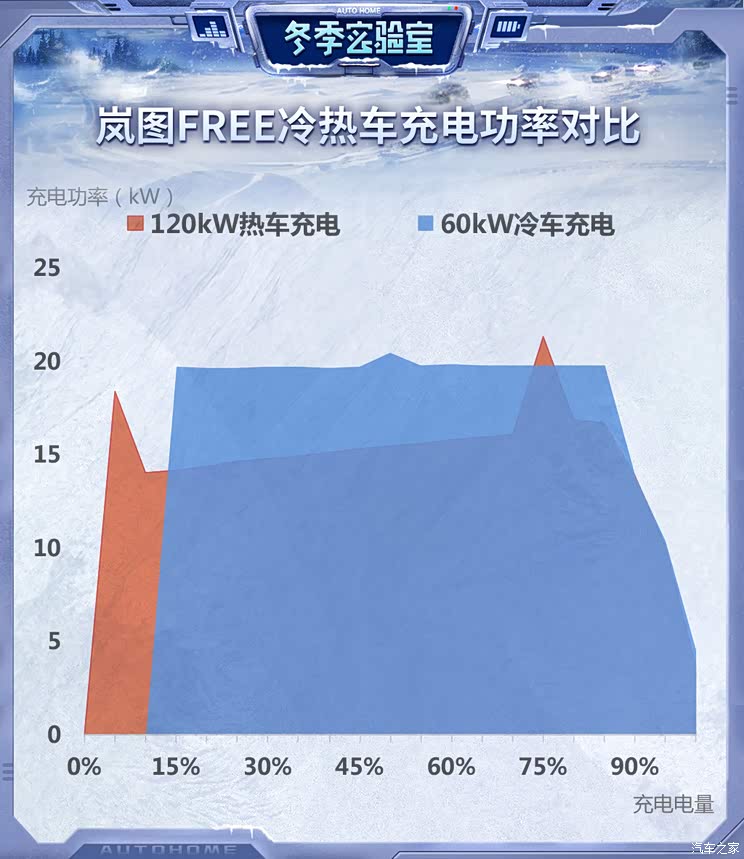
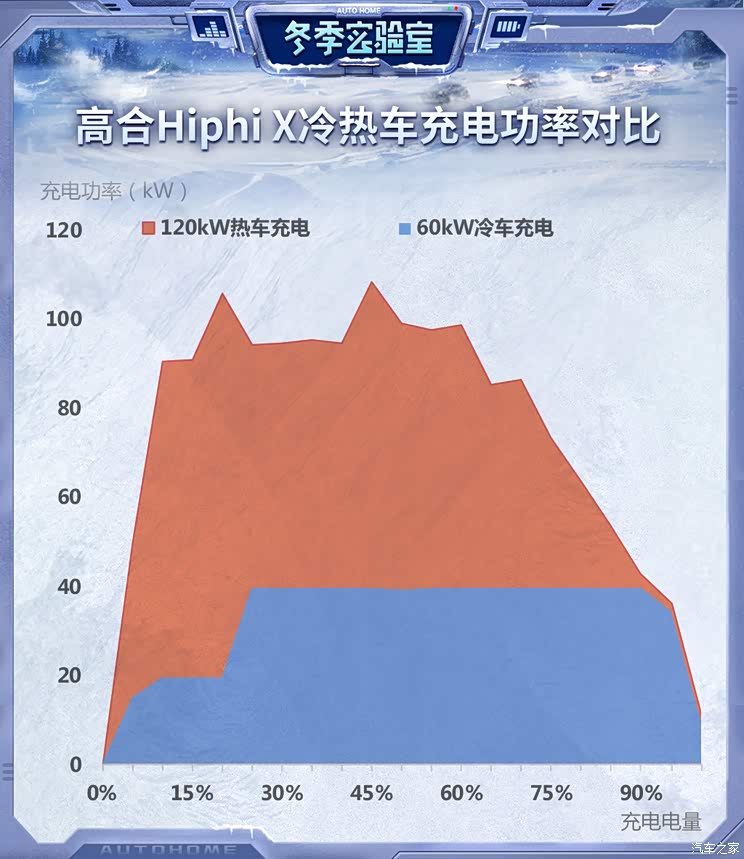
除岚图FREE外,其余全部测试车辆均能在60分钟内完成30%-80%充电,10款车型可以在40分钟内完成这一充电过程。所以在条件允许的情况下,车主应尽量选择120kW及以上的充电桩并在热车状态下进行补能,大幅降低充电的时间成本。不过,宝骏KiWi EV、欧拉好猫以及岚图FREE也出现了与60kW充电桩功率相同、充电效率并未提升的情况。
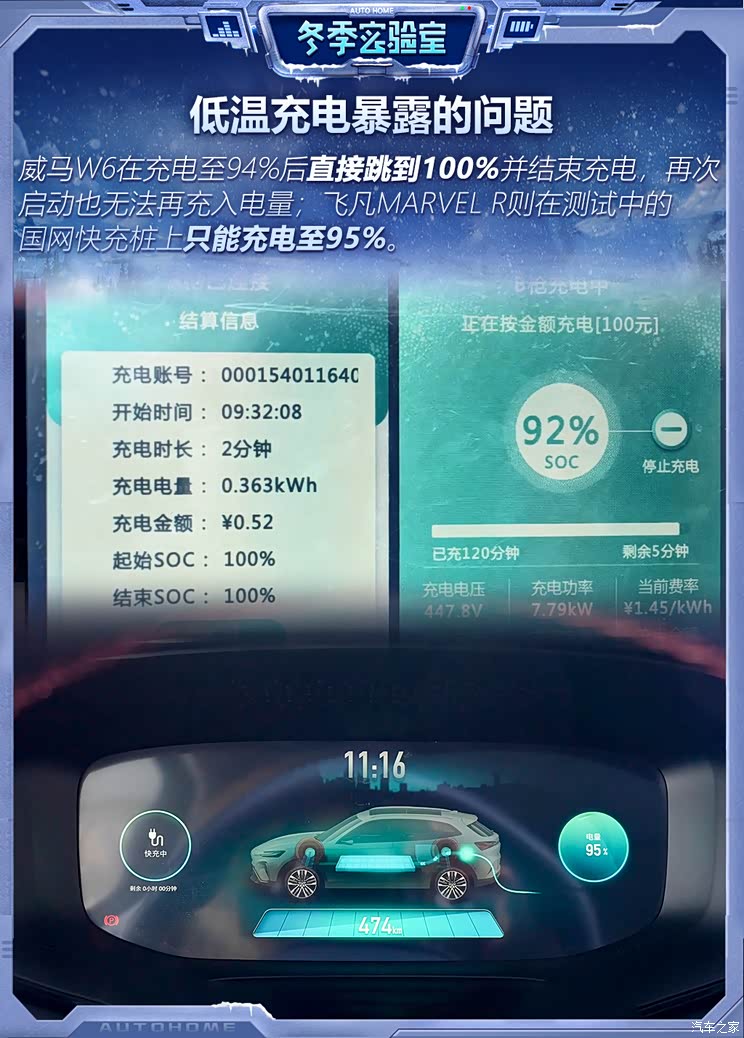
此外,威马W6在充电至94%后直接跳到100%并结束充电,再次启动也无法再充入电量;飞凡MARVEL R则在测试中的国网快充桩上只能充电至95%,品牌方表示对快充进行了限制,使用慢充才能充满。这样的充电逻辑虽然能有效避免电池过充,有助于延长电池寿命,但却过于简单粗暴,在车主需要出远门时如果无法真正满电出发,无疑会加剧用户的续航焦虑。想要增加电池的安全性,车企应该拿出相应的技术手段,而不是无脑的单方面锁电、让用户买单。
测试结论
From the results of cold car charging, outdoor low temperature standing has a significant impact on the charging power of the battery pack. In response to the problem that lithium iron phosphate batteries are afraid of cold, Tesla Model Y and Baojun KiWi EV have not done a corresponding strategy in the charging process, and the charging efficiency cannot be plug and play. Obviously, for their owners, cold car charging should be avoided as much as possible. So if pure electric vehicles are idle for more than a few days in winter, try to park the vehicle in the underground garage to protect the power battery.
According to the charging test under the two working conditions of cold car charging and hot car charging, users should give priority to charging in the hot car state, 120kW and above charging piles in winter charging, and make good use of the 30% -80% stage with faster charging speed, which can significantly shorten the time required for charging. In daily use, if there is no long-distance driving demand, it is also recommended that you use the car in the 30% -80% stage to reduce the full charge of the battery, which not only protects the battery but also improves the charging efficiency.
● Extreme cold standing, overnight battery life actually evaporated 7%? What’s the problem?
After chatting about battery life and charging, in the winter laboratory for several consecutive years, we found that whether the battery life of the vehicle will evaporate significantly after standing overnight will also cause trouble for us to travel in winter. We usually park at night and arrange the next day’s itinerary according to the remaining battery life. However, if we get up the next day and the remaining battery life "evaporates" for no reason, we need to increase the number of charges. If it is heavy, it is very likely that the vehicle will be lying on the road directly, which will seriously affect our itinerary.
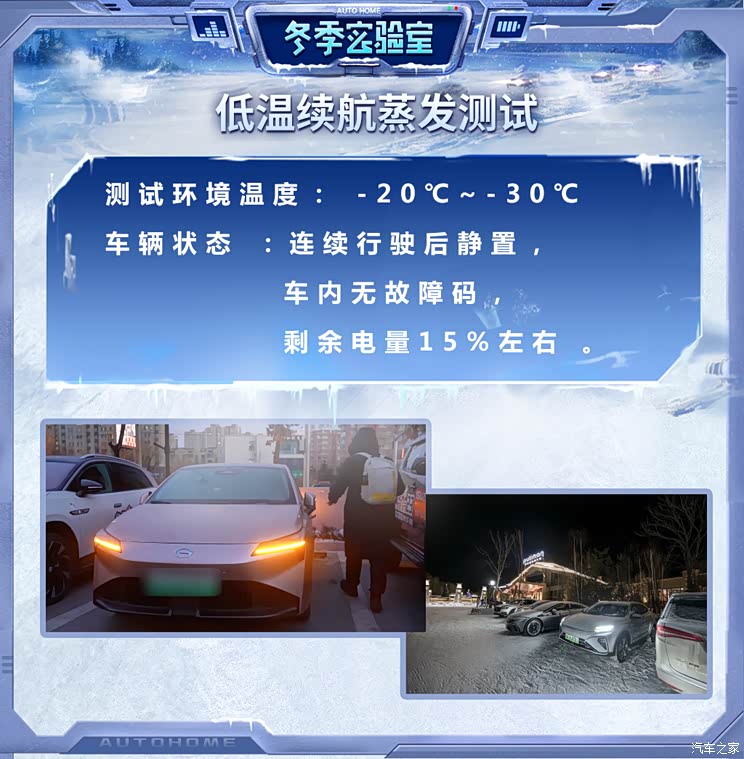
In fact, the real purpose of this test is to check the accuracy of the vehicle SOC battery power calculation, whether it can efficiently and accurately calculate the remaining power and remaining battery life, just like the "self-ability" assessment before the college entrance examination. Accuracy is very important.
Evaporation of battery life exists, and individual models affect travel planning
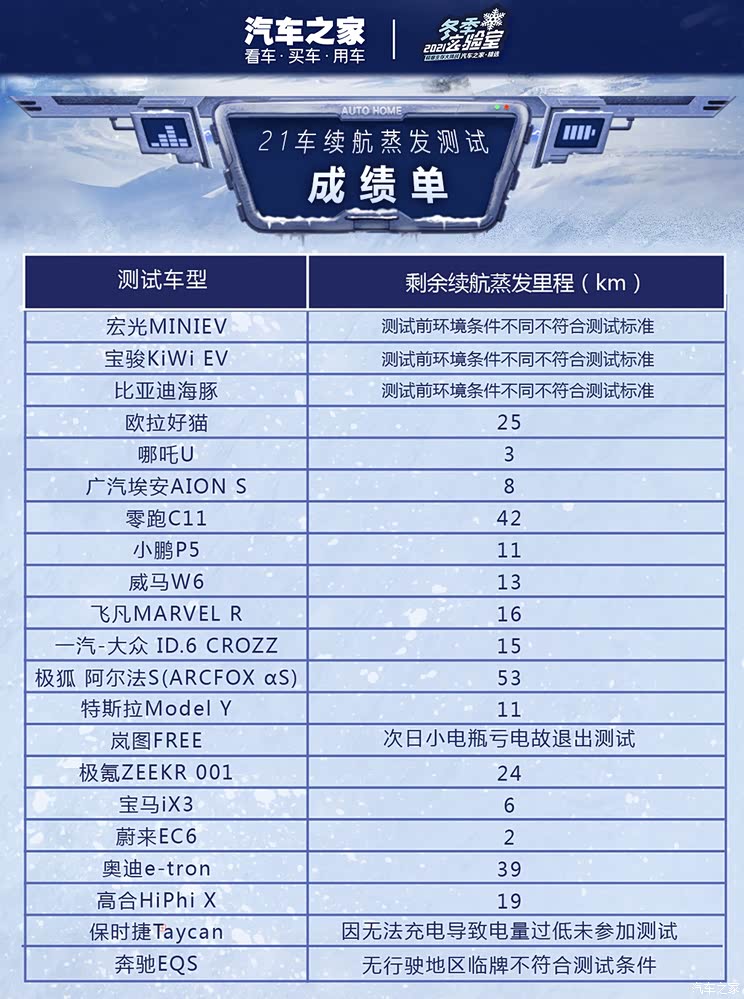
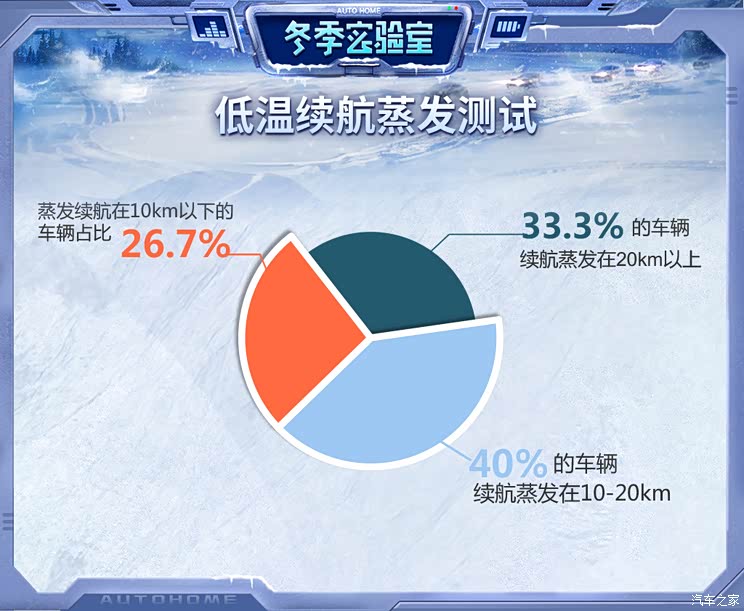
The test results show that the proportion of models with a battery life of more than 20km on the second day is about 33.3%, and the proportion of models with a battery life of less than 20km is 66.7%. It shows that due to the characteristics of the battery pack, the vehicle will re-estimate the remaining power and battery life after a night in a low temperature outdoor, and the remaining cruising range will have a certain "evaporation" to some extent. However, an excellent estimation strategy is to dynamically adjust the displayed mileage to control the "evaporation value" within the range that does not affect the next day’s travel.
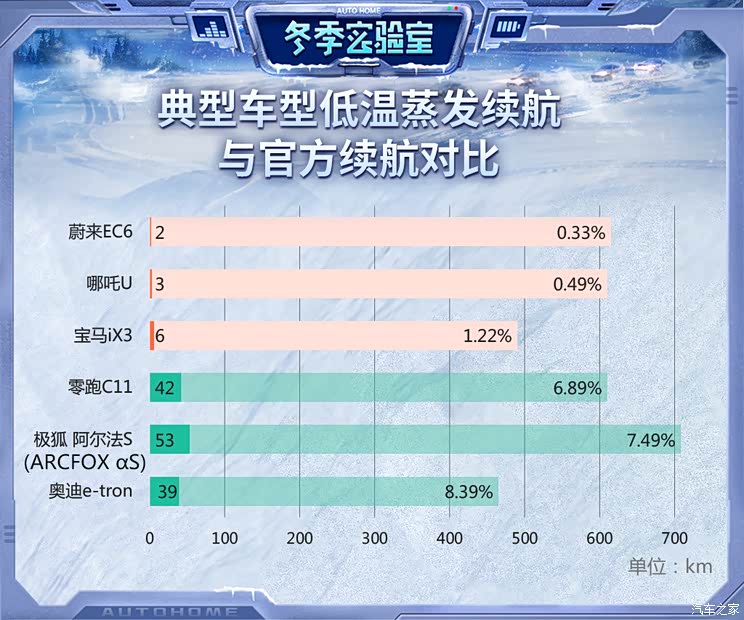
After testing, we found that more than half of the vehicles, the decline in battery life is not serious, evaporation value compared to the official total mileage, are within 3%, NIO EC6, Nezha U, BMW iX3 and other models of battery life changes are only single digits, will not affect the next day’s travel, within the acceptable range. But there are also some vehicles that have evaporated more than 30km of battery life, such as Audi e-tron, Extreme Fox α coefficient S and Zero C11, about 7% of the official battery life is missing, and the original planned destination or charging location is likely to fail to arrive, seriously affecting travel.
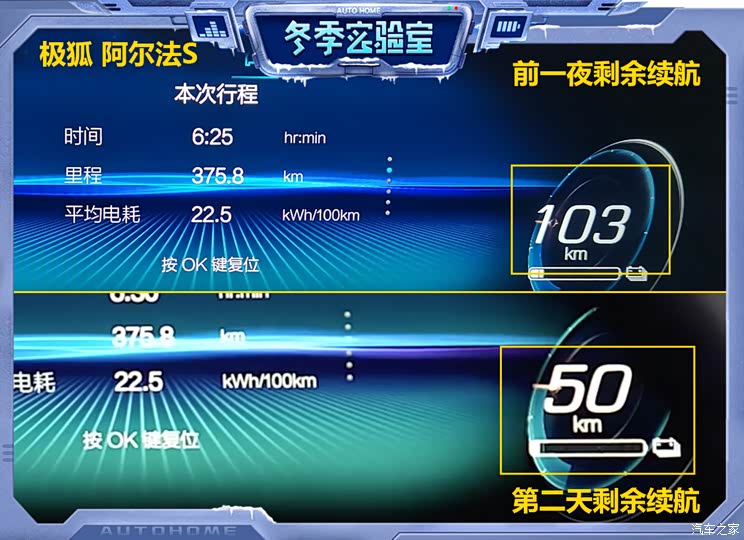
测试结论
This test also reflects the differences in the estimation algorithms for the remaining power and battery life of different vehicles. The algorithm can accurately present the owner with real-time dynamics and more accurate display of battery life. If the algorithm is not accurate, it will turn the remaining battery life into a "happy table", which will not only fail to give the owner accurate instructions, but also increase the psychological anxiety of the owner.
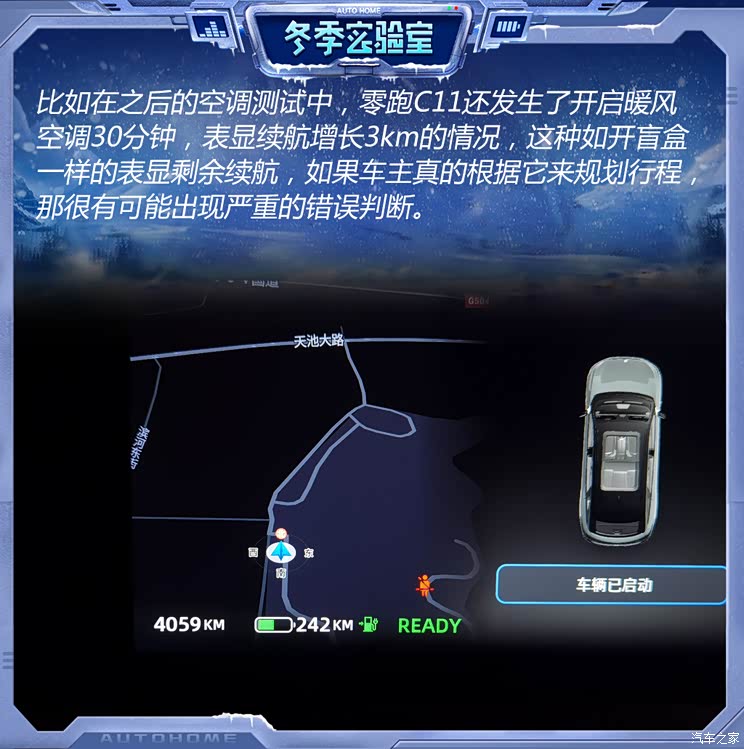
Therefore, electric vehicle owners need to keep in mind that in the low temperature environment in winter, if there is a situation of overnight travel, they must reserve more power. They can make travel plans based on the remaining battery life of the next day to shorten the charging interval. And the setting of the supplementary plan is also the same as our suggestion in the charging section. In winter, it is necessary to more reasonably formulate the travel radius.
● PTC or heat pump? The truth about battery life "killer" air conditioners
Driving in winter, in order to ensure a relatively comfortable environment, turning on the air conditioner is a necessary option, but for electric vehicles, the heating of the air conditioner requires additional power consumption, and the battery life falls quickly when turned on, and it is too cold when not in the car. The dilemma makes it a headache for electric vehicle owners. In order to restore the real car environment of users, we verify the rapid heating ability of the air conditioner in the low temperature state, as well as the energy consumption and the impact on the cruising range in the low temperature air conditioner heating test.
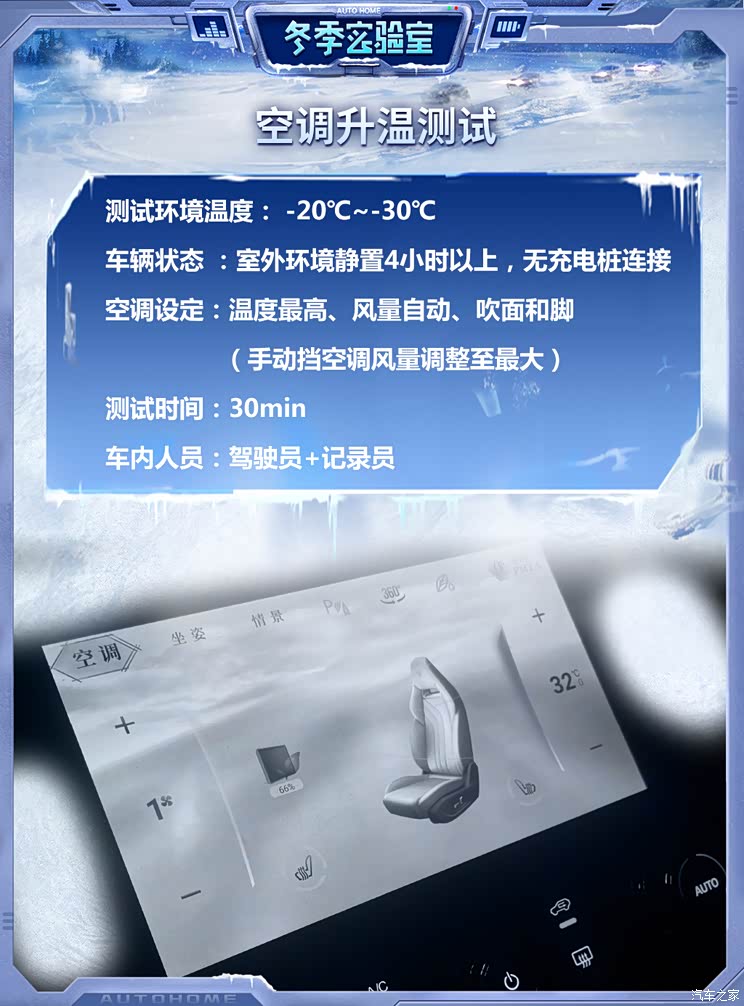
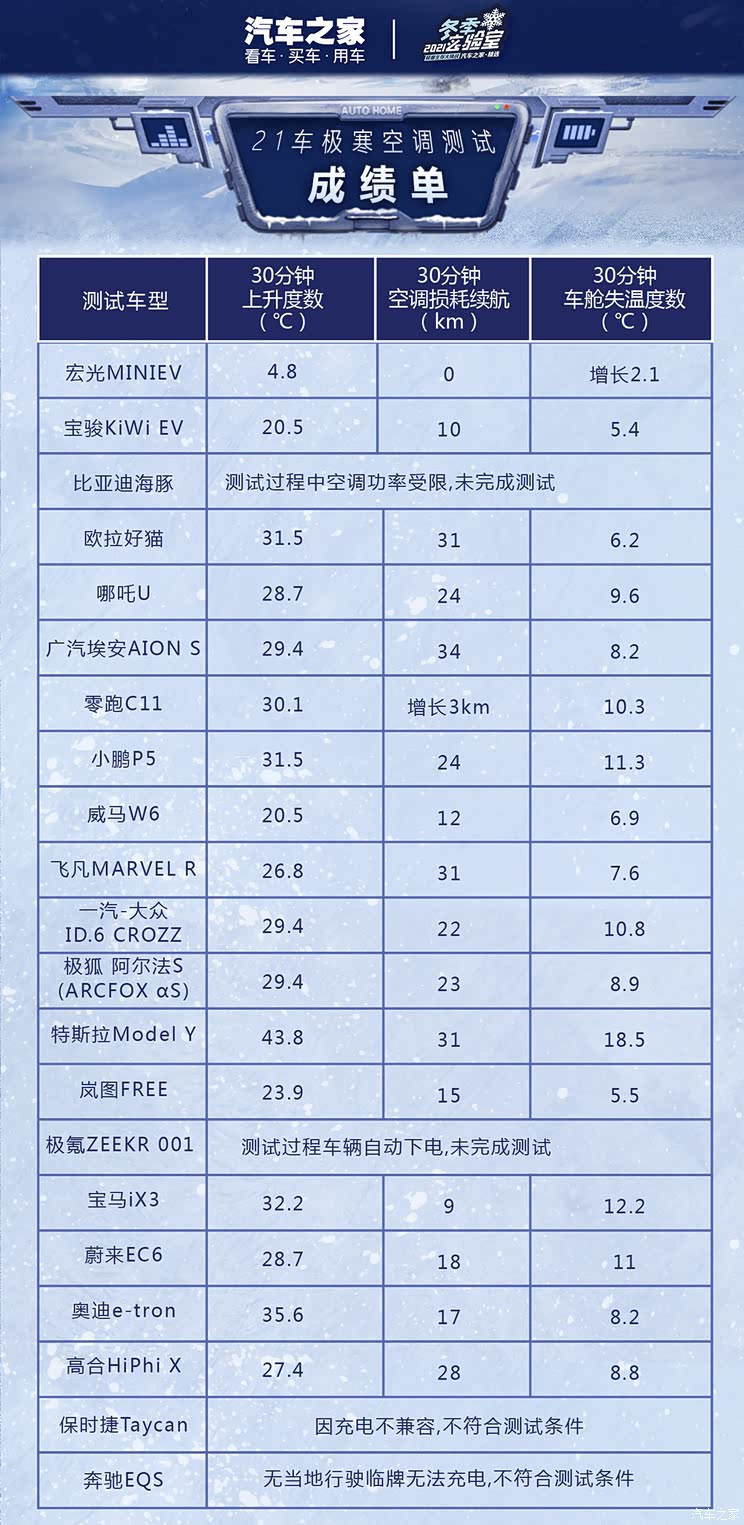
It can meet the heating demand, but the power difference is obvious
The test results show that most electric vehicles can bring a comfortable temperature to the cabin during the 30-minute heating process of the air conditioner. Except for Hongguang MINIEV, the temperature in the cabin of other vehicles has risen by more than 20 ° C, and the temperature in the cabin of more than one-third of the vehicles has risen by more than 30 ° C. The test results prove that the PTC or heat pump air conditioner of the current pure electric vehicle can bring satisfactory heating capacity even in extremely cold environments.
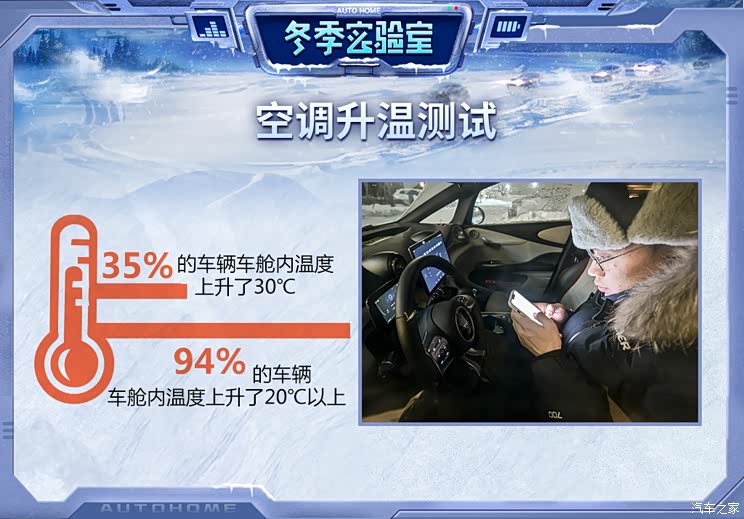
The Hongguang MINIEV, in the air conditioning test, experienced a 30-minute temperature rise of less than 5 ° C. The tester also said that the air conditioner had almost no heating effect during the process, and the final cabin temperature rise was 4.8 ° C or caused by human body heat. This speculation was also re-examined during the battery life test to check the performance of the air conditioner.
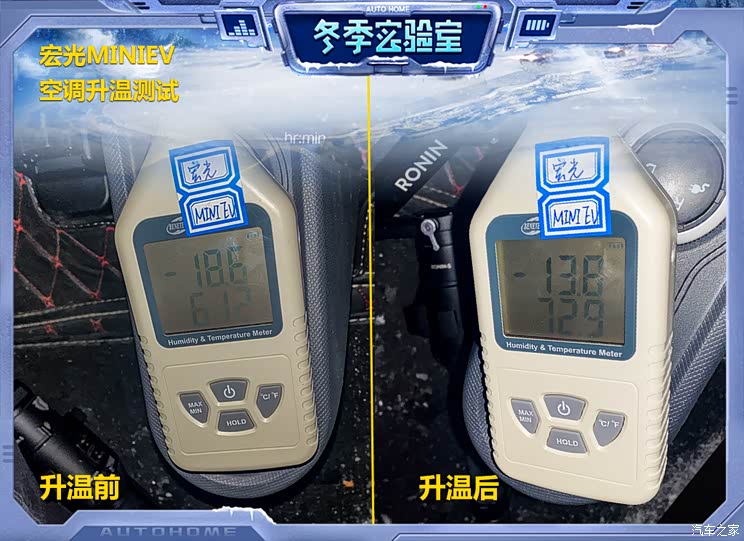
But at the same time, we also see that the power performance of different models of air conditioners varies greatly, resulting in significantly different heating effects in the cabin. For example, the Tesla Model Y and Audi e-tron with better heating performance are significantly different from the Weimaraner W6 and Baojun KiWi EV with a heating temperature of only about 20 ° C, and the testers have obvious differences in heating up. Therefore, as in previous winter laboratory tests, the setting of the heating air conditioner power also represents the brand’s understanding of energy consumption.
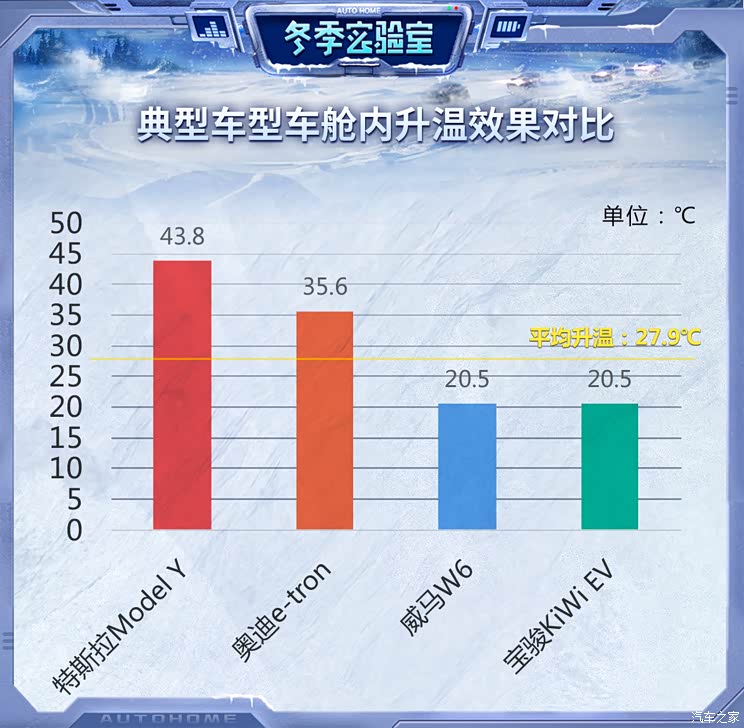
There is no obvious difference in heating capacity between heat pump and PTC air conditioner
In addition, we also found that in the -20 ° C environment, the heating capacity and energy consumption effect of the air conditioner have little to do with the type of technology used, but are mainly closely related to the logic of the air conditioner setting. There are two main types of air conditioners on the market these years, PTC electromagnetic heating and heat pump + PTC combination. Among the models participating in the test, the proportion of vehicles using these two air conditioning technologies is approaching. It should be noted here that in fact, many models using heat pump air conditioners do not simply use a heat pump, but actually use a combination of heat pump + low-pressure PTC auxiliary heat.
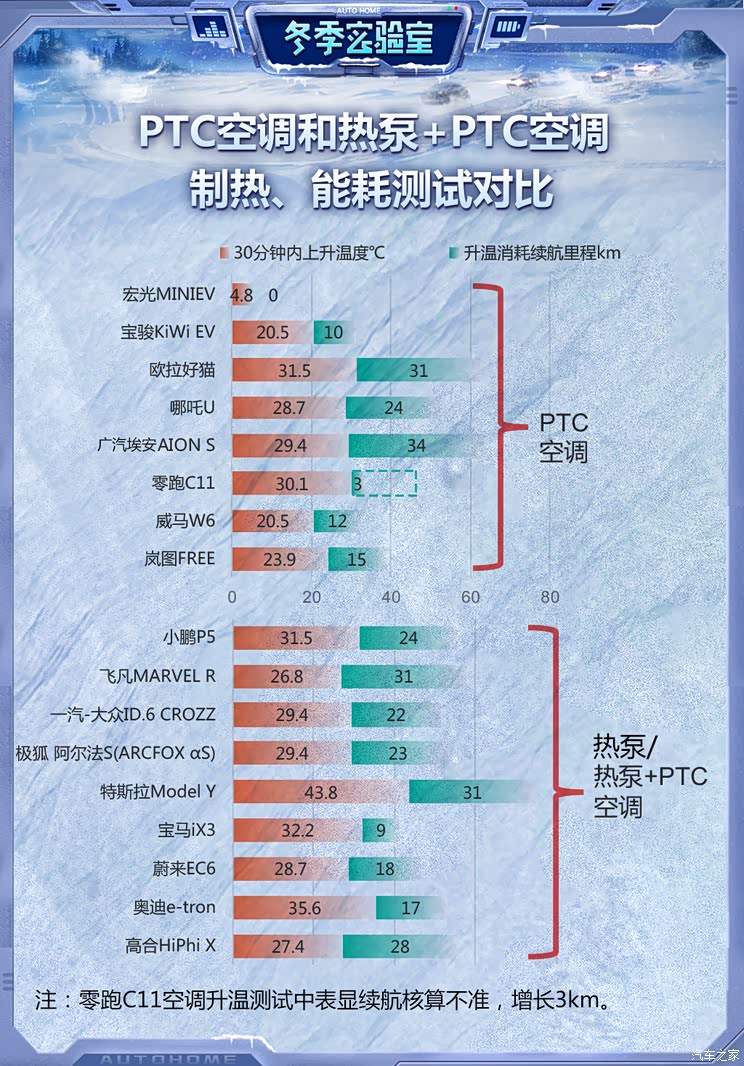
但测试结果显示两种类型的空调效果都有好有差,PTC空调并未出现比热泵+PTC空调更好的制热能力。例如,采用热泵+PTC空调技术的奥迪e-tron,车内温度上升了35.6°C,采用PTC空调的威马W6,30分钟内仅上升了20.5°C。而即便同一种类型的空调技术,也会因为品牌采用不同的策略而得到不同的制热结果,比如与奥迪e-tron同样为热泵+PTC组合的飞凡MARVEL R,车内温度也仅上升了26.8°C,两者差值近10°C。
暖风空调 能耗与温度的抉择
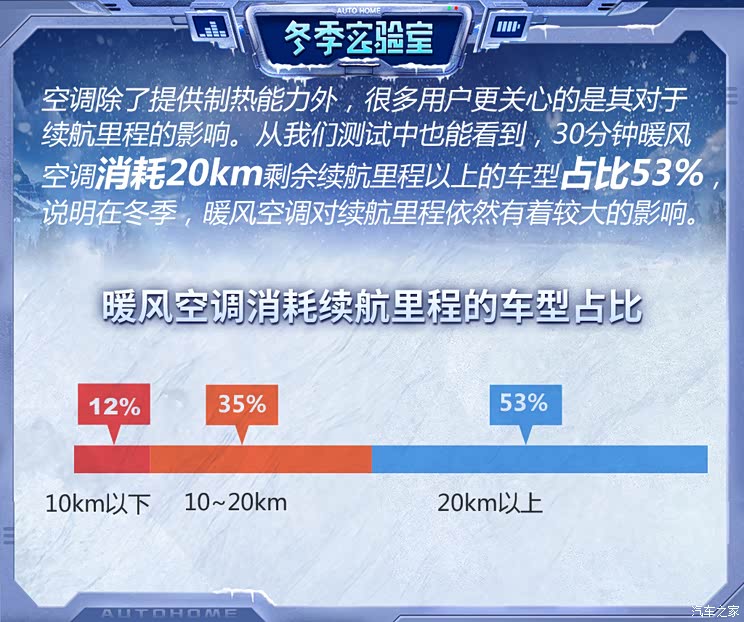
因此我们衡量电动车暖风空调好坏不能只看制热能力这一项,能耗同样关键。从此次测试中,我们也能看到不同车型的空调设计在制热和能耗上的侧重,比如特斯拉Model Y就是看重制热能力,牺牲能耗。反观宏光MINIEV,则选择保住续航里程,但测试中车内的温度几乎没有提升,车内驾乘人员感到非常冷。当然,最好的策略是在制热和能耗中找到平衡,例如宝马iX3,30分钟车舱升温了32.2°C,续航仅减少9km,既能有暖和的车舱环境,能耗也不会对续航造成过大影响。
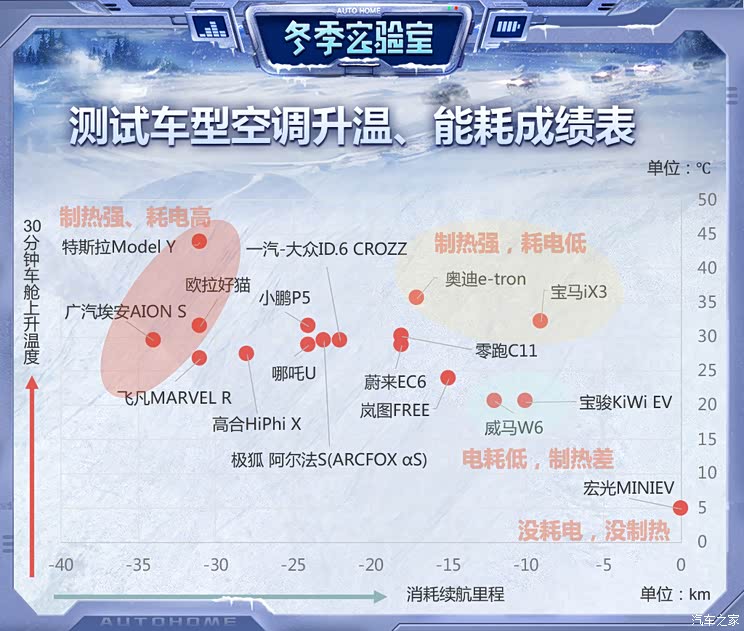
要暖和还是要续航?选择权应交还给用户
那如果您作为车主,是更愿意在冬季有更好的续航表现,还是更好的车舱内的舒适温度呢?对于这个问题,我们已经提出过很多年了。但事实上,大家的需求不一,车企其实可以将选择权交还给车辆使用者,只需要通过简单的软件设定,即可给空调增加节能和舒适两种模式的选择。在智能化配置大行其道的当下,即便是车辆已经交付,其实也可以通过OTA的形式,来解决空调能耗依然存在的短板。
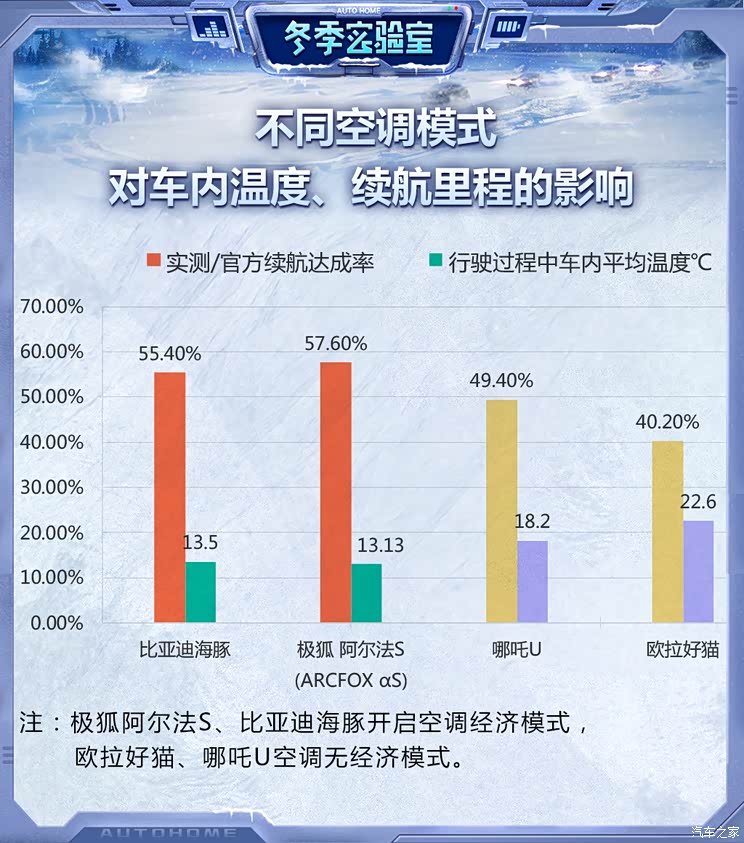
Going back to our car use scenario, especially in winter, when the car is in urgent need of air conditioning heating, everyone must hope that the best effect of air conditioning can be achieved quickly. On the contrary, when we need a longer cruising range for long-distance travel, the energy-saving air conditioning mode becomes another need. To solve these two scenarios, in fact, only two modes such as "comfort" and "energy saving" can be set, and the choice is completely left to the user.
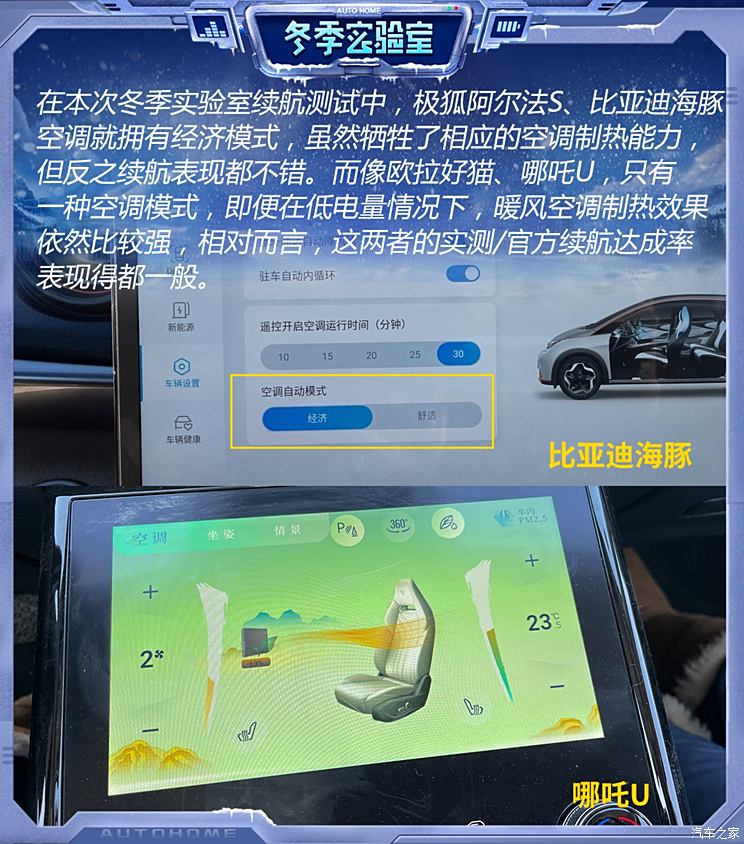
测试结论
Air conditioning testing is also a test item that users are very concerned about in the winter laboratory every year. If your car environment is in the cold northern region, when choosing to buy a vehicle, you don’t have to pay too much attention to the type of warm air conditioner used by the vehicle. The heating effect is not obvious from the test results. And if your vehicle air conditioner does not provide options such as "comfort" and "energy saving", then we recommend that you manually control the temperature range according to real-time demand when using the car every day, especially when the vehicle is low in power, do not let the air conditioner bring higher energy consumption pressure.
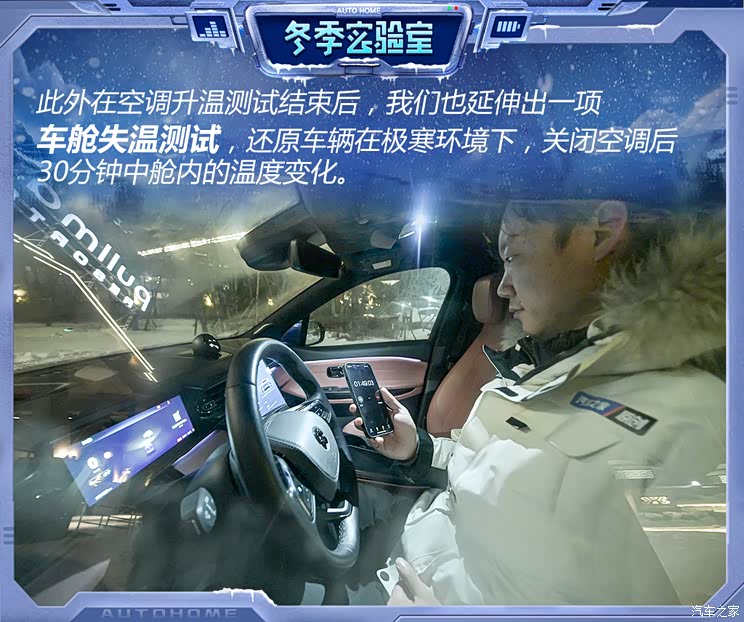
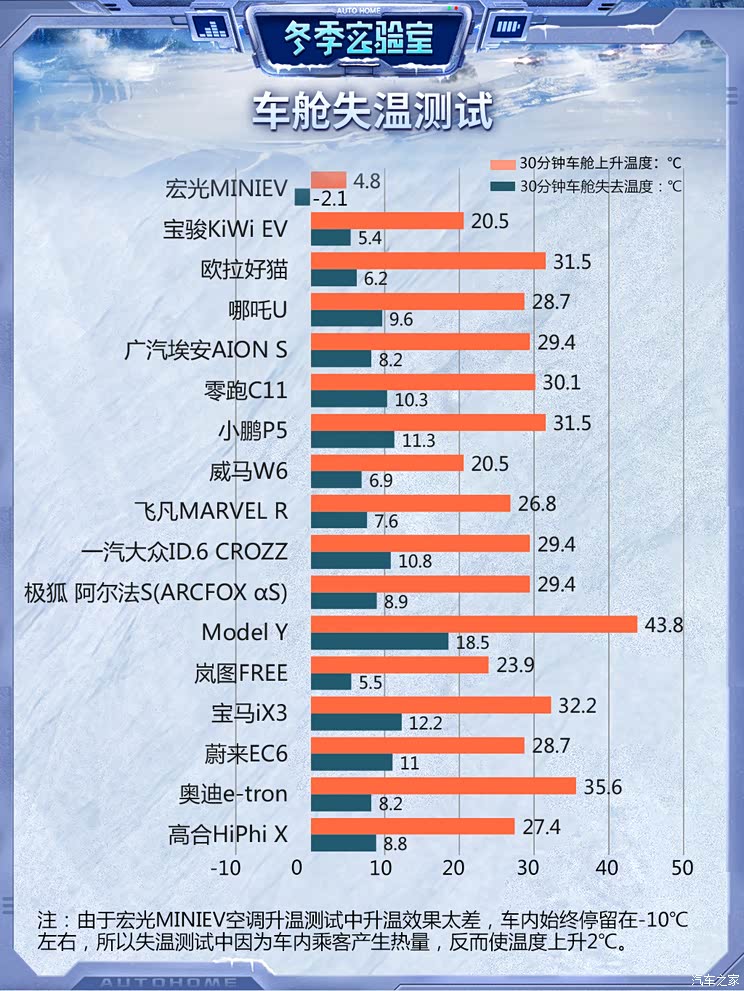
So when traveling in winter, we try not to put ourselves in such an extreme situation, replenish power in time, plan our vehicle’s replenishment arrangements reasonably, and try to put ourselves in a more comfortable environment. In winter, if the vehicle is really lying down due to battery exhaustion and other reasons, we must also pay attention to personal warmth, and stop in a safe area in time when we find that the vehicle is gradually losing power.
Details need to be optimized, and remote control can greatly enhance the car experience
At present, more and more models are equipped with remote app vehicle control services. In addition to remote unlocking, users can turn on comfort functions such as air conditioning in advance before boarding the car, thus providing a more comfortable car experience. However, in this winter laboratory remote vehicle control test, we found that some vehicles would fail or be delayed in remote control at low temperatures.
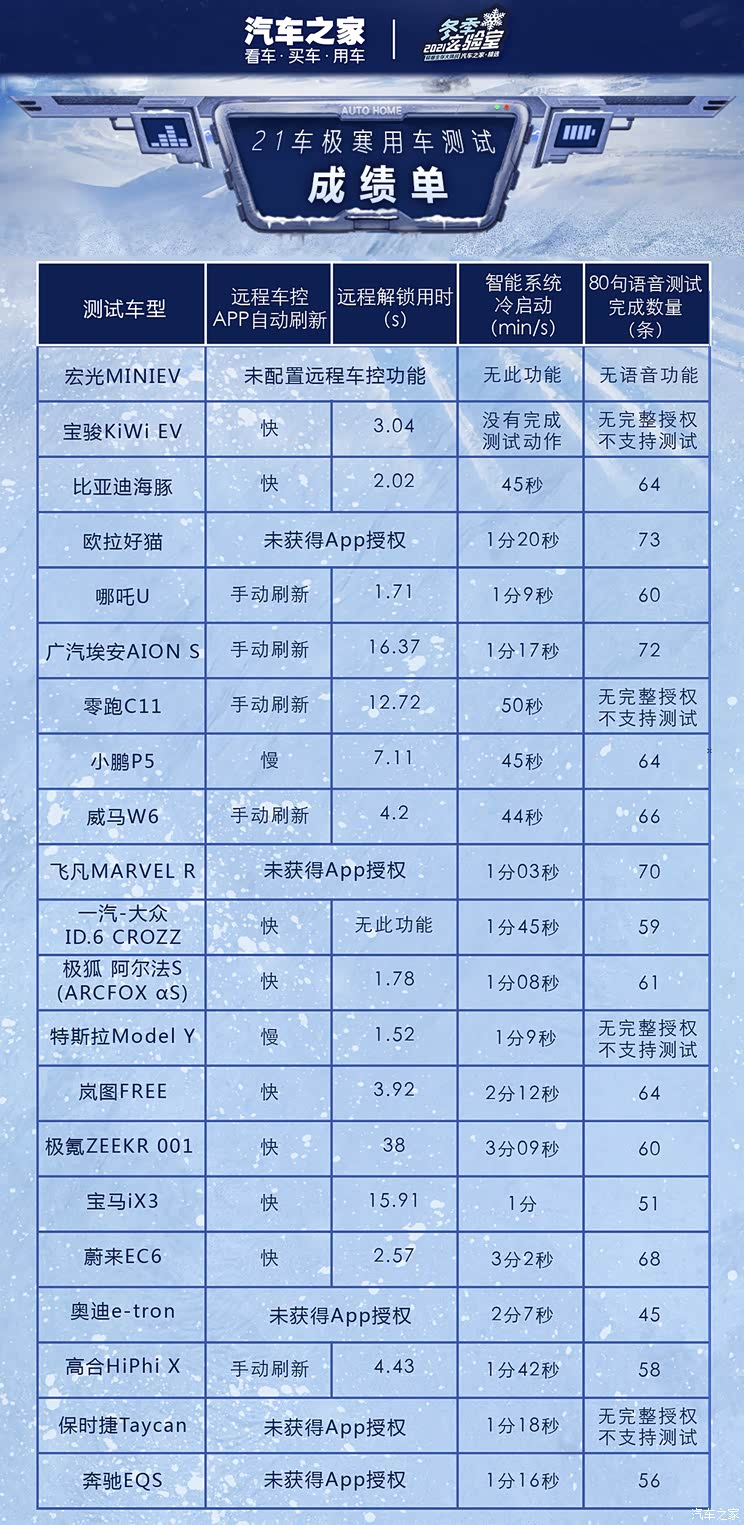
We found that all models equipped with remote app services also have differences in app experience. In addition to the number of supported functions, the ease of operation and response also vary greatly. For example, some models in the test did not support automatic refresh, requiring users to manually refresh before communicating with the vehicle.
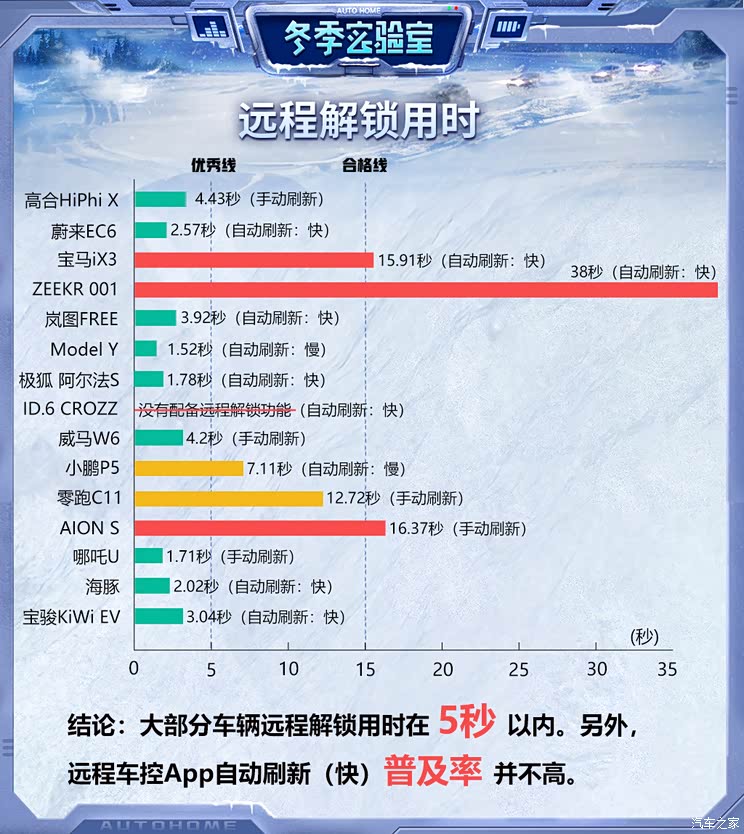
手机App远程解锁车门测试部分,在已获得远程手机App授权且具备远程车控功能的15款车型中,只有一汽-大众ID.6 CROZZ并未配备远程解锁功能,其余车型均可正常完成操作,但解锁用时差异较大,比如特斯拉Model Y、比亚迪海豚、极狐 阿尔法S(ARCFOX αS)等车仅用时1~2秒左右便完成了操作,响应及时。而像ZEEKR 001耗时38秒之久,未能有效发挥远程解锁的功能。
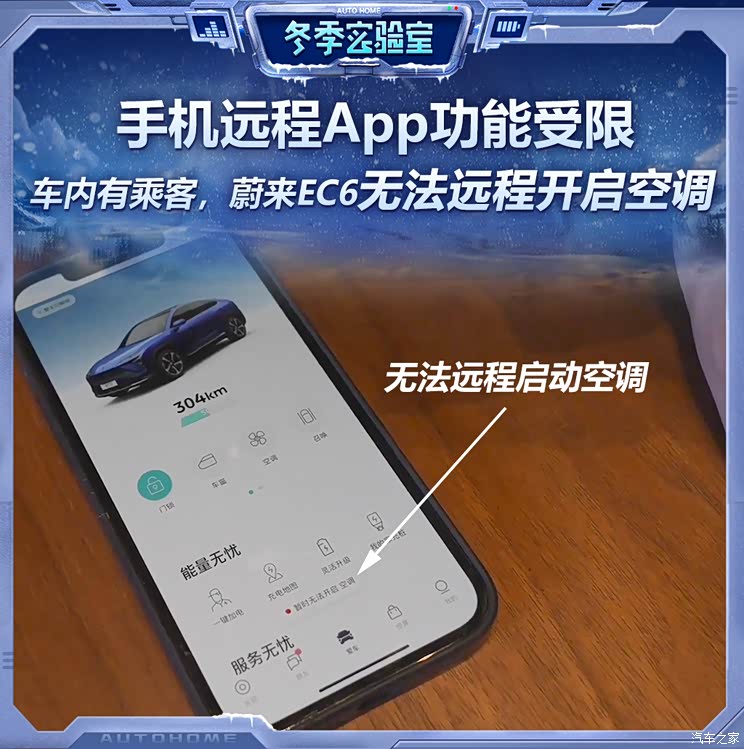
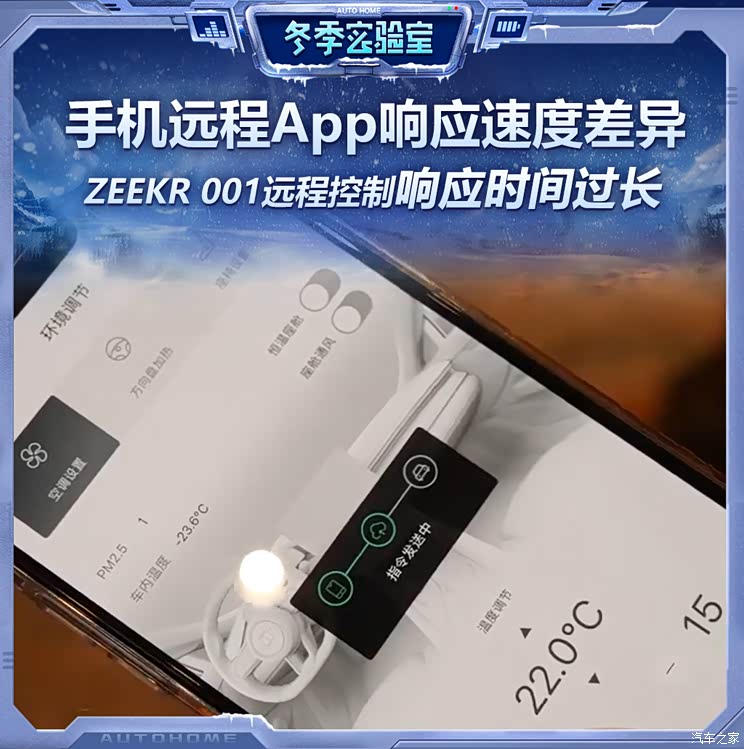
手机App远程启动空调测试中,宝骏KiWi EV、岚图FREE、蔚来EC6三款车型无法成功完成操作,其余大部分车型可在8秒内成功启动空调,只有极狐 阿尔法S(ARCFOX αS)、ZEEKR 001明显耗时较长。
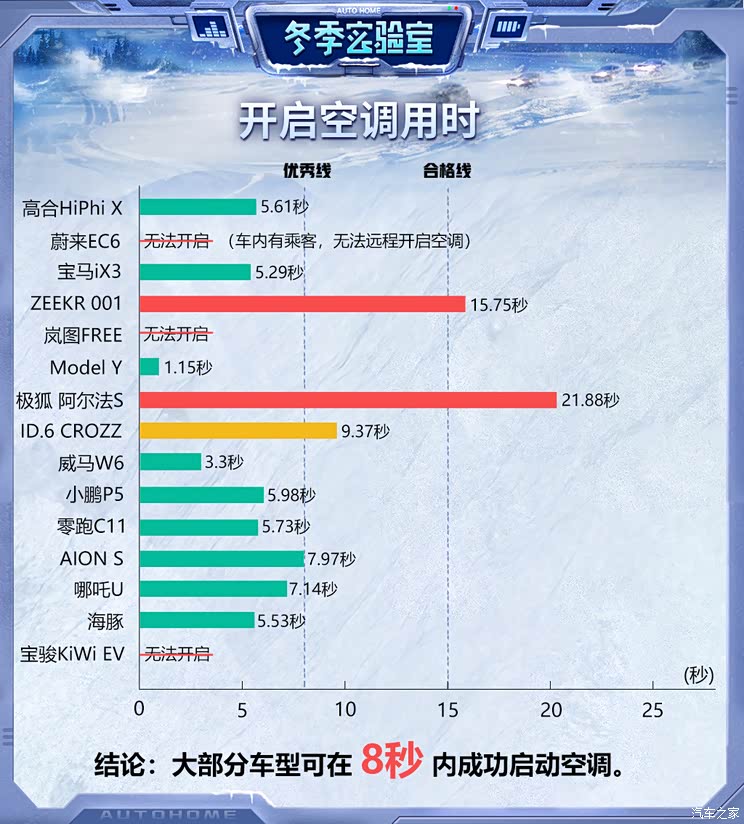
测试结论
测试中我们发现,远程App各品牌的体验优化差距较明显,但多数车型可以满足用户需求,所以我们强烈建议若您的车拥有远程App服务,不要认为是一个鸡肋的功能,当熟悉使用后可大大提升用车便利性。
测试结果也能够看到,表现突出的品牌例如特斯拉Model Y、比亚迪海豚等车可以实现流畅的操作以及丰富的功能支持,且在响应上也有优秀的表现。反之,个别品牌会存在功能支持不全,例如ID.6无法实现远程解锁,岚图FREE及宝骏KiWi EV无法远程启动空调。而ZEEKR 001在两项功能测试中,都出现了严重的启动延迟问题。用户需要耗费过多精力,使得“便利功能”并不便利,甚至会打击用户尝试新功能的积极性。反之,可迅速完成操作的车型则能在高效率前提下为用户提供舒适的用车体验。

关于蔚来EC6,官方解释称因车内有乘员,所以无法通过远程App开启空调,在使用逻辑上和其他车型有所不同。所以如果您遇到车内有老人、儿童,想远程开启空调的情况,请注意蔚来EC6并不能完成该操作。
● 隐藏式门把手打开率堪忧
目前隐藏门把手已经成为车辆设计的新趋势,尤其对于新能源汽车而言,隐藏门把手不但能带来更美观的外观设计,也能够辅助降低车身风阻实现更高的续航能力。我们此次的21款测试车中,有13款车型都没有采用传统的机械门把手,取而代之的是三种类型的隐藏式门把手,比如特斯拉Model Y、宝骏KiWi EV、ZEEKR 001这3款车型采用隐藏式手动门把手,而奔驰EQS、蔚来EC6、小鹏P5等9款车型采用隐藏式电动门把手,最后一类是以手动模式作为电动弹出设计的冗余,采用隐藏式手动+电动门把手的保时捷Taycan。
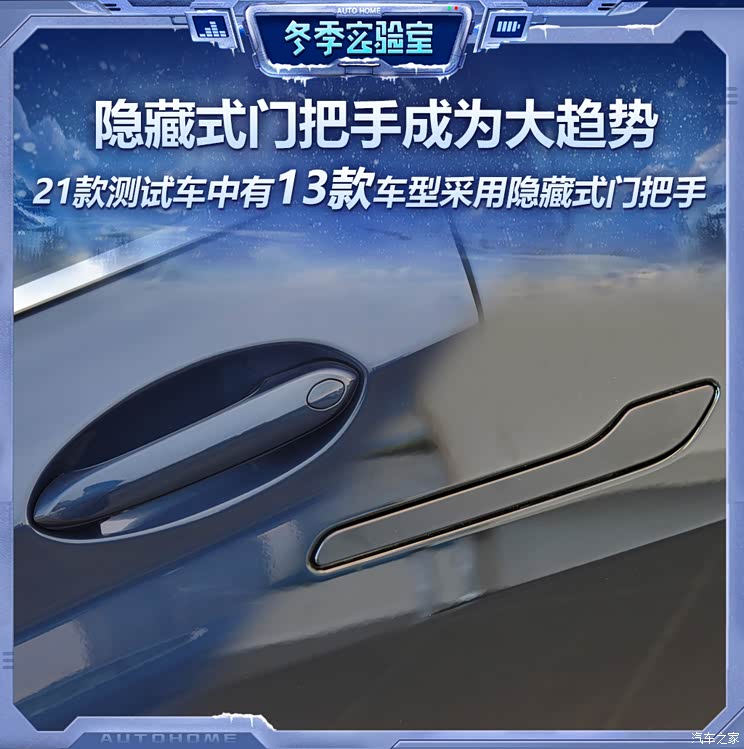
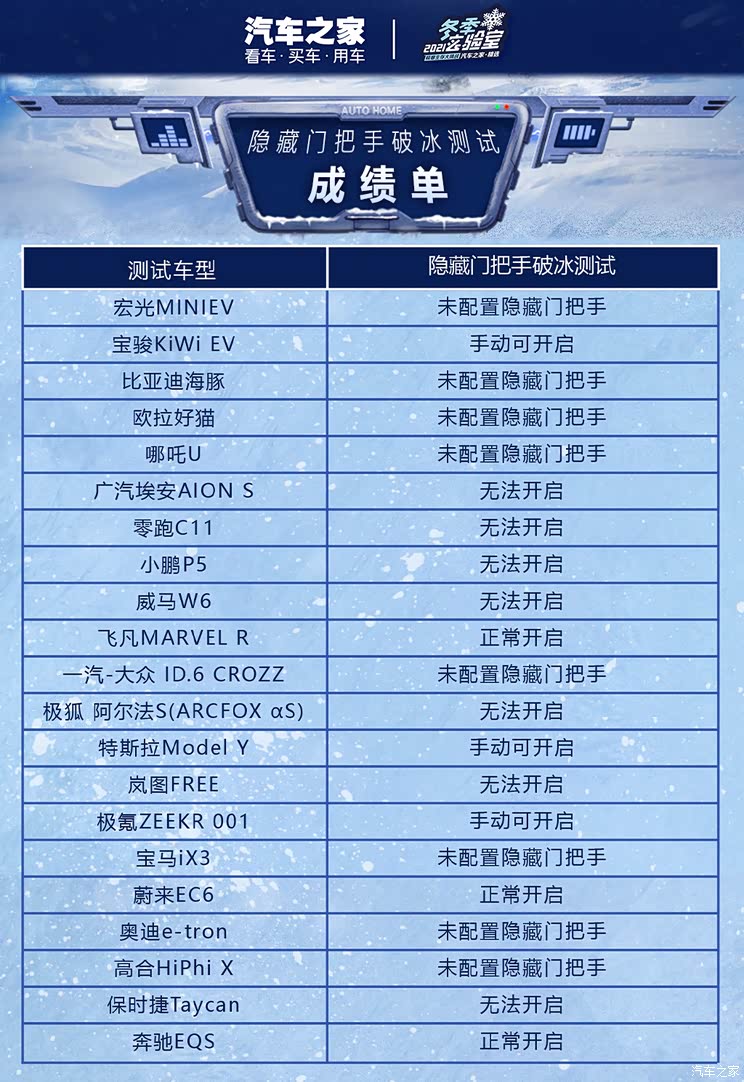
所以在隐藏门把手测试中,我们希望还原冬季车主在洗车后或者遇到雨雪天气,门把手是否会因为结冰或低温造成无法正常开启的情况出现。结果上,采用隐藏式手动门把手的3款车型在门把手被冰冻后均可手动开启门把手,稳定性较好。而隐藏式电动门把手车型中,只有飞凡MARVEL R、蔚来EC6、奔驰EQS三款车型的门把手可以“破冰而出”正常开启,其余车型或因为门把手扭力不够等原因无法弹出,直接造成车门无法开启。
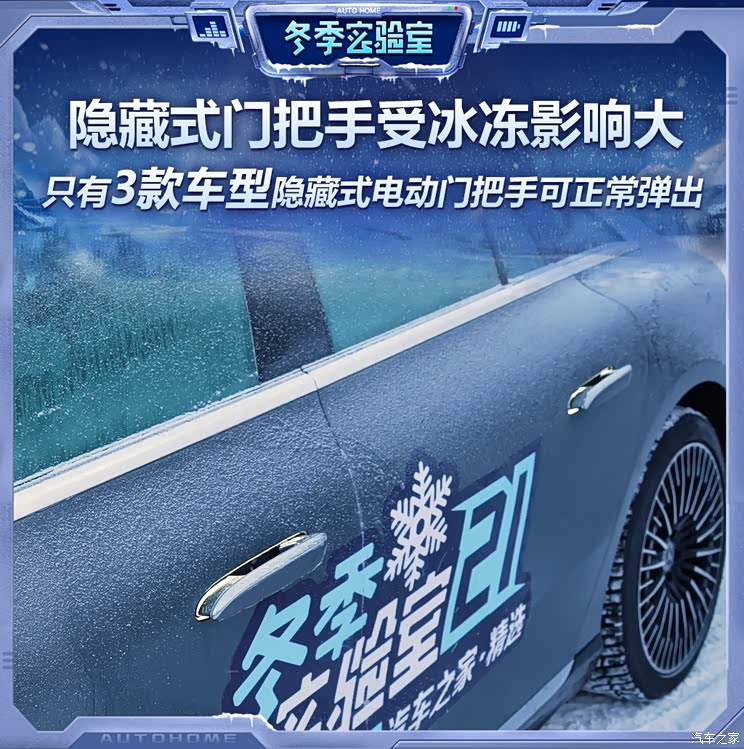
另外我们还发现,在此次冬季实验室5天的测试过程中,也有部分车型因低温或其它原因导致相关模块失效或反应缓慢,以至于用户无法第一时间顺利开启车门,比如奔驰EQS、ZEEKR 001就出现了即便没有被冰雪覆盖,门依然在开启车辆后无法正常弹出,测试人员现场不得不从副驾驶甚至尾箱进入车内。
测试结论:
当隐藏式设计已经成为了趋势时,使用稳定性应该同时跟进。但我们发现在测试中,只有小部分车型的隐藏式门把手能够通过“冰冻测试”,这显然不是理想结果。与远程App控制此类非刚需功能不同,门把手是我们每次用车都要涉及到的,无法正常开启显然是严重影响了我们的用车体验。
目前有一些车企其实有对应的解决方案,例如保时捷还有特斯拉都提供了车窗及门把手加热功能,来解决被冰雪覆盖无法开启的问题。但目前一些中低端车型并未配置。因此,我们也在网络上发现了一些除冰剂的道具,来解决严寒地区门把手或者车门并冻住这种尴尬情况。
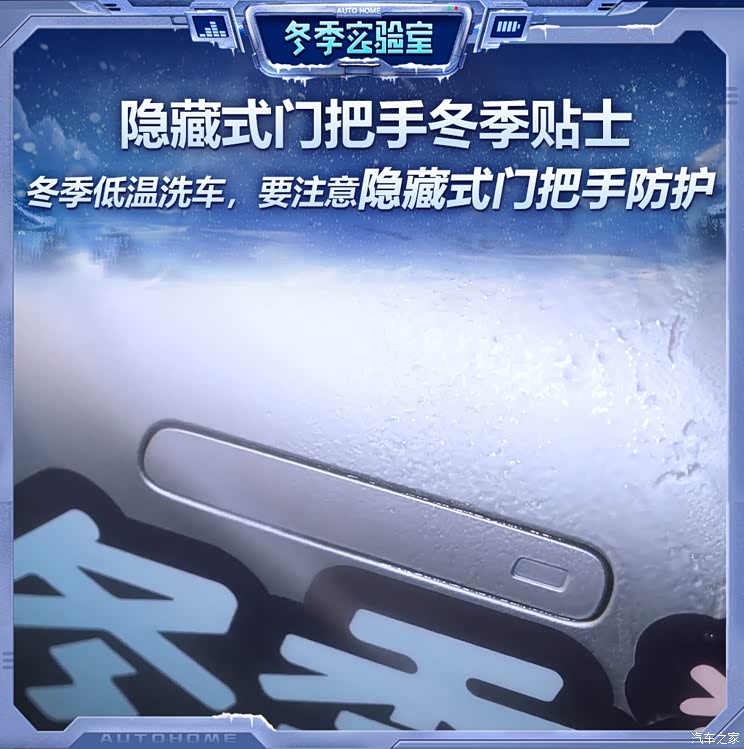
综上所述,对于用户而言,如果您的爱车采用隐藏式电动门把手,且要经历低温洗车等情况,我们建议您做好门把手防护,比如在锁车状态下洗车,或者及时清理门把手周围水渍以防结冰等。如果您遇到了隐藏式门把手被冻住无法打开的情况,也尽量不要用蛮力解决,以防相关部件损坏。条件允许的话,建议您用浇热水或使用除冰剂等方式对门把手进行解冻。
车机系统冷启动
随着车辆上的电子器件以及智能化功能增多,低温对于启动效率和稳定性会造成影响,屏幕延迟,语音迟滞以及能否正常使用挡位,都与我们的用车密切相关。在低温环境下,车辆冷启动能否依然保持正常使用效率,是我们策划低温冷启动测试的初衷。
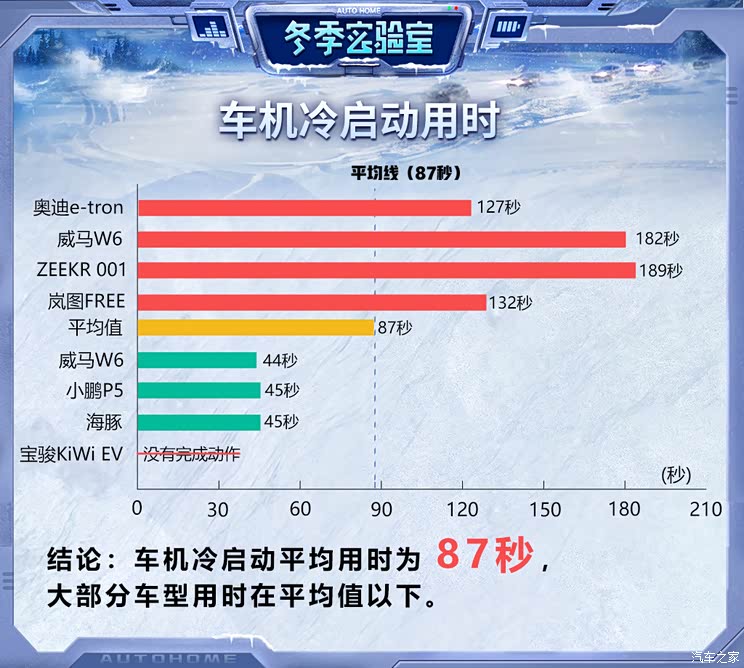
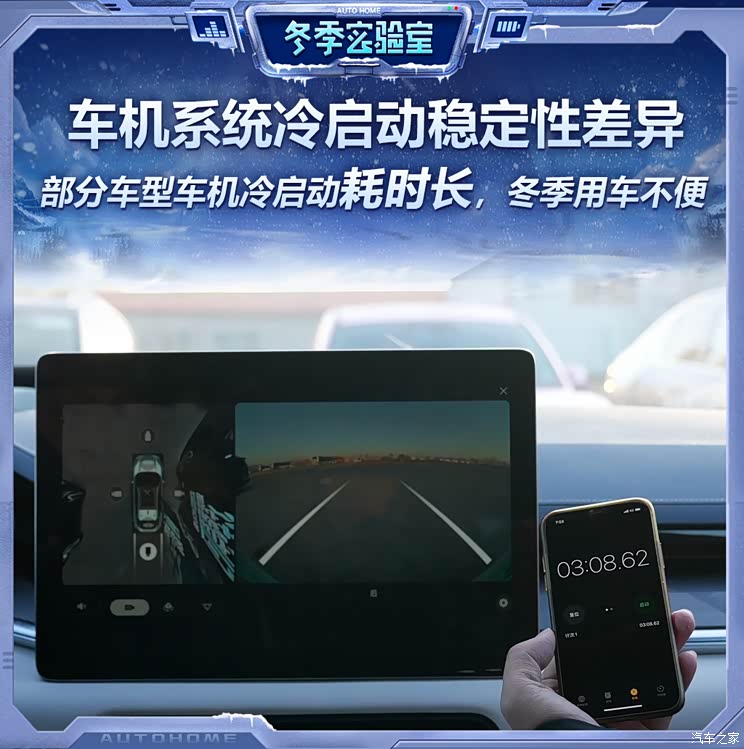
我们此次的21款测试车中,岚图FREE、奥迪e-tron耗时超过2分钟才完成车机冷启动的相关操作,蔚来EC6、ZEEKR 001耗时更是超3分钟,甚至宝骏KiWi EV根本没有完成操作;这意味着对于以上车型而言,用户冬天上车需要耗费较长时间才能完成常规操作再出发。作为对比,比亚迪海豚、小鹏P5、威马W6等车型只需要不到1分钟即可完成相同操作。车机系统在低温环境下的操作延迟带来的用车影响显而易见,谁也不希望在车里白白冻几分钟吧。
● The dangers of driving on ice and snow
The purpose of planning the four test projects in the driving control section of the laboratory this winter was to convey to everyone that on ice and snow roads, the driving habits we habitually maintain on dry ground at room temperature have different degrees of danger. Safe driving and understanding of vehicle stability systems are also driving knowledge brought by all conclusions.
So in the end, although we have the specific test data of the vehicle on the ice and snow road, we still recommend that you look at it correctly. All the data only represent the performance of the vehicle under extreme ice and snow road conditions, and compare it with the dry road. The more subjective conclusions of the test and the problems we found deserve more attention and discussion.
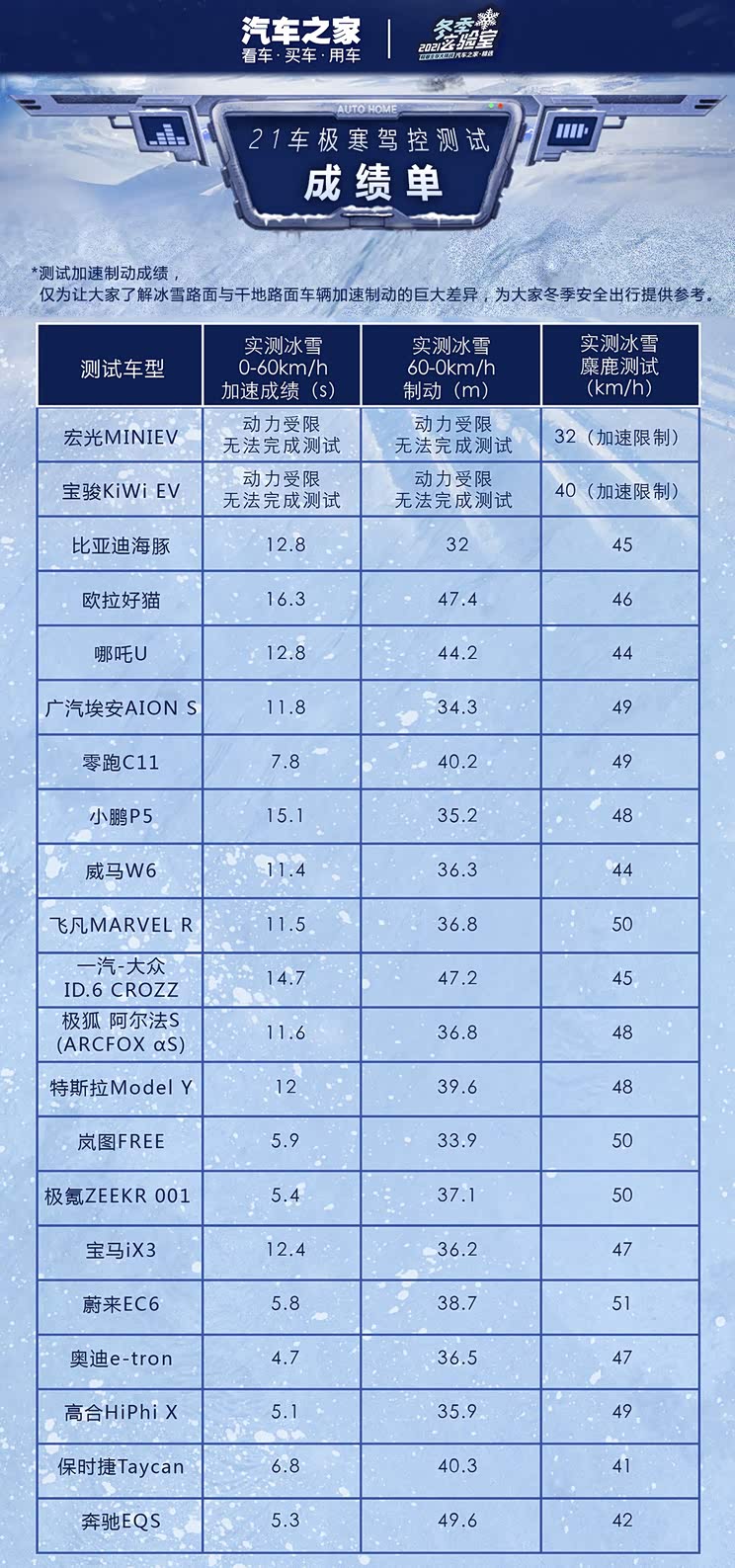
Replacing snow tires, the necessity of ice and snow roads
In this winter laboratory, all test vehicles were replaced with the original standard winter snow tires of the same size. During the battery life and driving control tests, we found that the winter snow tires have a significant improvement in the driving stability of the vehicle in winter. The conclusions of all our tests are also based on the performance of the vehicle after using the winter snow tires. Therefore, whether you are using the car in extremely cold areas for a long time or occasionally traveling to cold areas for a short time, we strongly recommend that you replace the winter snow tires, which can greatly improve driving safety by upgrading the tires.
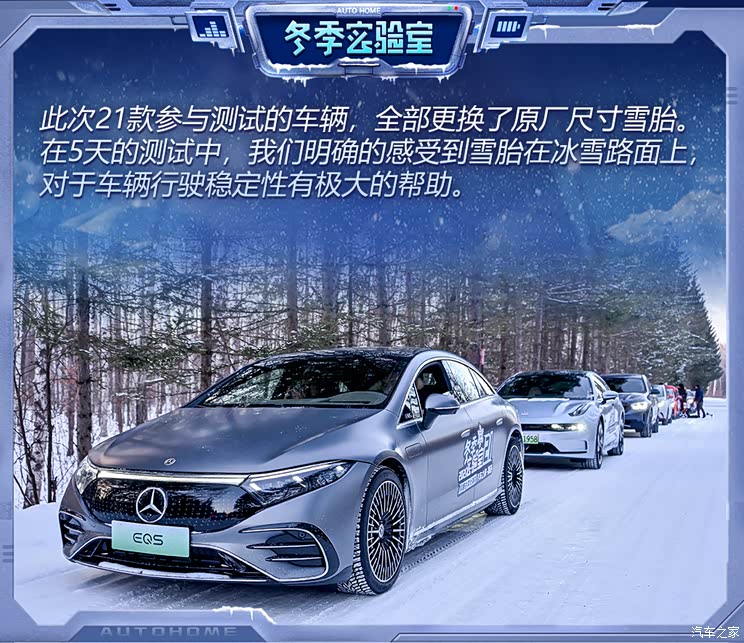
In this winter laboratory vehicle preparation stage, we found that many vehicles are equipped with four-season tires as standard, and many users also believe that four-season tires can support winter ice and snow weather. But in fact, the low temperature resistance of four-season tires is worse than that of winter snow tires. Even in extremely cold weather, winter snow tires can still maintain reliable softness. In snow-covered sections, winter snow tires will also bring better engagement and grip with the ground, which has significantly improved stability for braking, steering, and climbing.
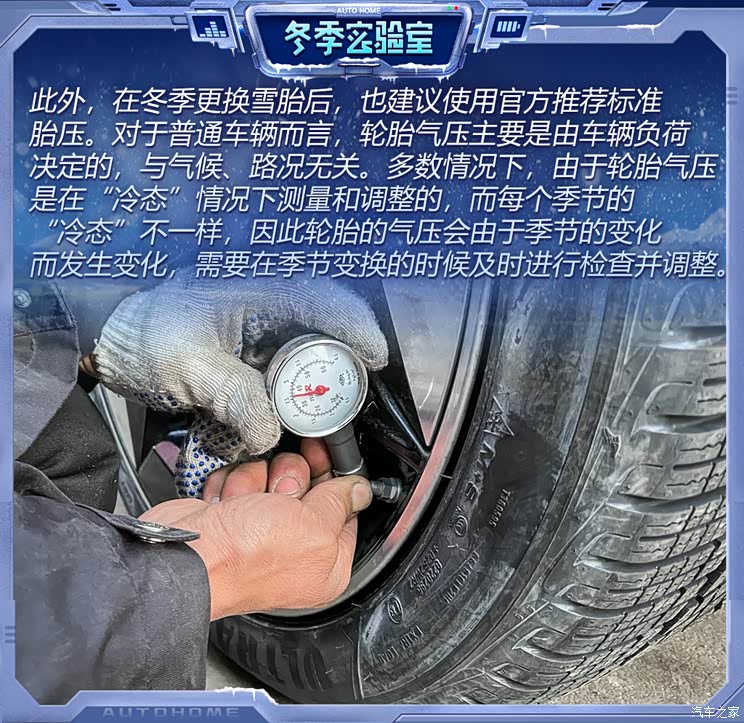
Complex variables, safety analysis of driving stability on ice and snow roads
In the driving test results, it can be seen that the 0-60km/h acceleration and braking ability of the vehicle have a significant impact, and the complex environment of real-time changes in the ice and snow road surface also amplifies the test of all aspects affecting the stability of the vehicle body, including power system torque, vehicle weight, tire (pattern), tire pressure, ABS intervention frequency, and so on.
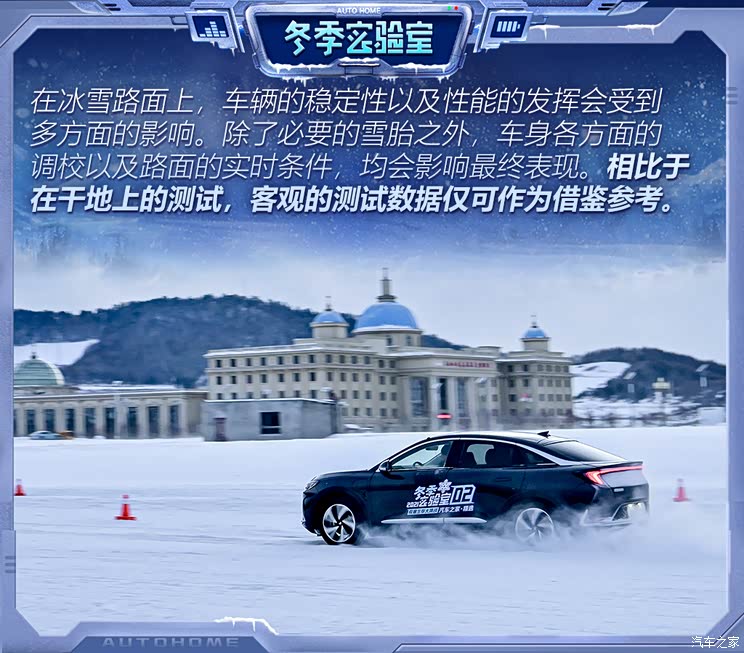
For this testing environment, we found that wider tires have better braking and acceleration on dry ground due to higher contact area with the road surface, but not necessarily on ice and snow roads. For example, in the tests of Mercedes-Benz EQS and Porsche Taycan, we found that the weight, torque, and tire width amplified the continuous skidding of the tires during acceleration, resulting in longer-distance sliding during braking (only for this test road surface).
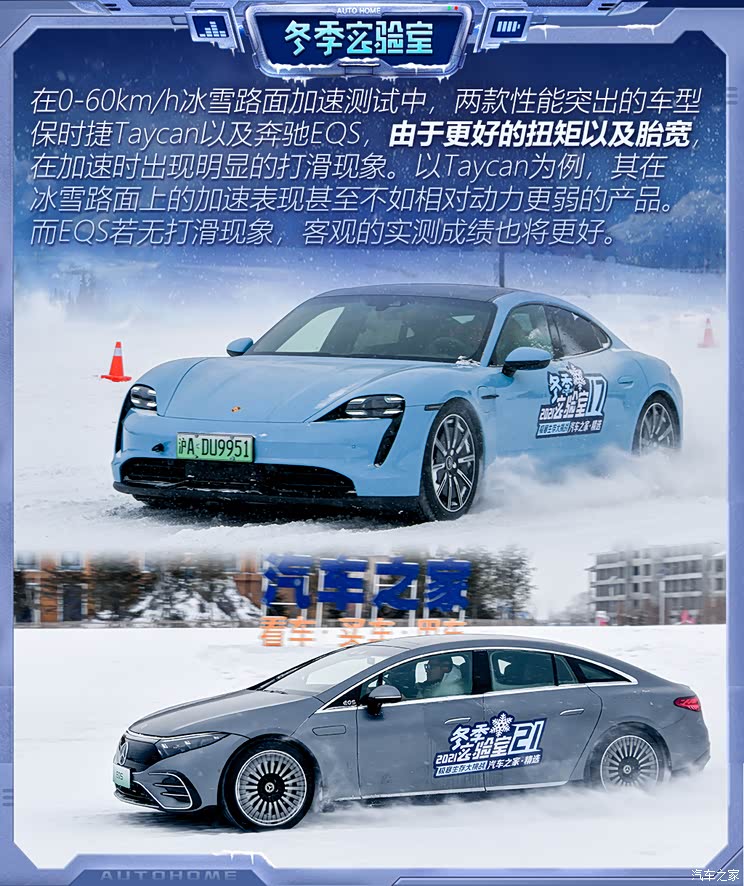
In addition, the working state of the ABS of the vehicle during braking will also affect the braking distance. For example, the braking distance of the Euler Good Cat 60-0km/h is 47.4 meters. The tester’s subjective feeling is that the working state of the ABS system of this car is the main reason for affecting the braking distance. But the BYD Dolphin achieved an unexpected braking distance of 32 meters. As the model with the narrowest tires in this test, it also matched the low weight of the car. On the contrary, because the single point pressure of the tread in contact with the road surface is greater, when braking, the tires will form a "snow pushing effect", and the soft snow squeezed in front of the tires also provides braking force in disguise.
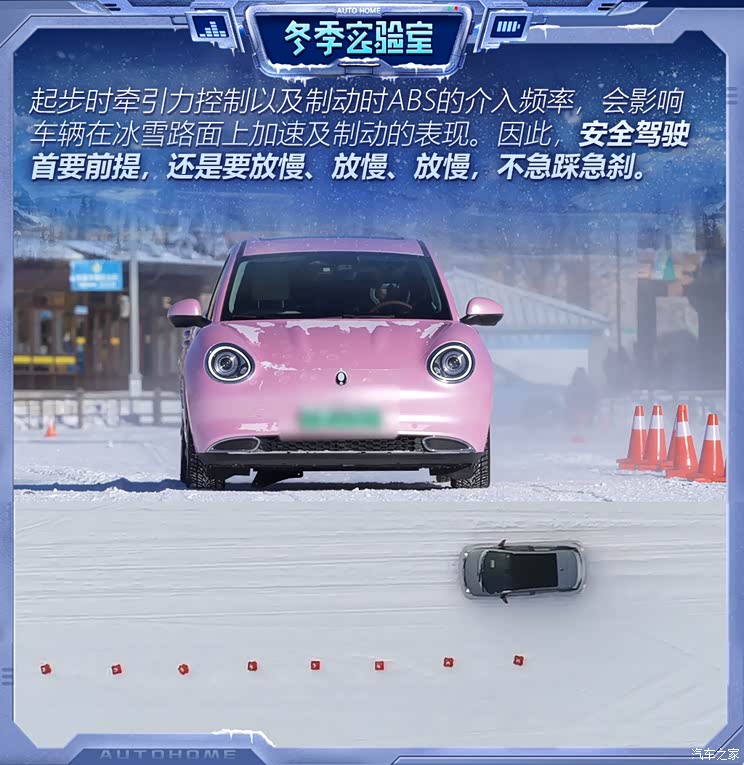
In addition, we can also clearly feel the help of the drive system for driving stability. Even for pure electric vehicles, the four-wheel drive system can also bring better handling stability. Under the premise of matching winter snow tires, whether it is acceleration, pile winding or elk testing, such as Audi e-tron, ZEEKR 001, Mercedes-Benz EQS and HiPhi X, there is a better subjective feeling of handling stability.
It is common sense that front-drive vehicles are more stable on ice and snow roads than rear-drive vehicles, but at the same time we also found in the test that the common feature of front-drive vehicles is that they will have understeer on snow, while rear-drive vehicles will have more oversteer problems, and these phenomena will bring serious hidden dangers on real roads. Therefore, whether it is front-drive or rear-drive models, special attention should be paid to slowing down and reducing sudden acceleration/deceleration operations on ice and snow roads in winter to avoid tire idling, and less triggering of TCS traction control system and ESC to ensure the consistency of power output.
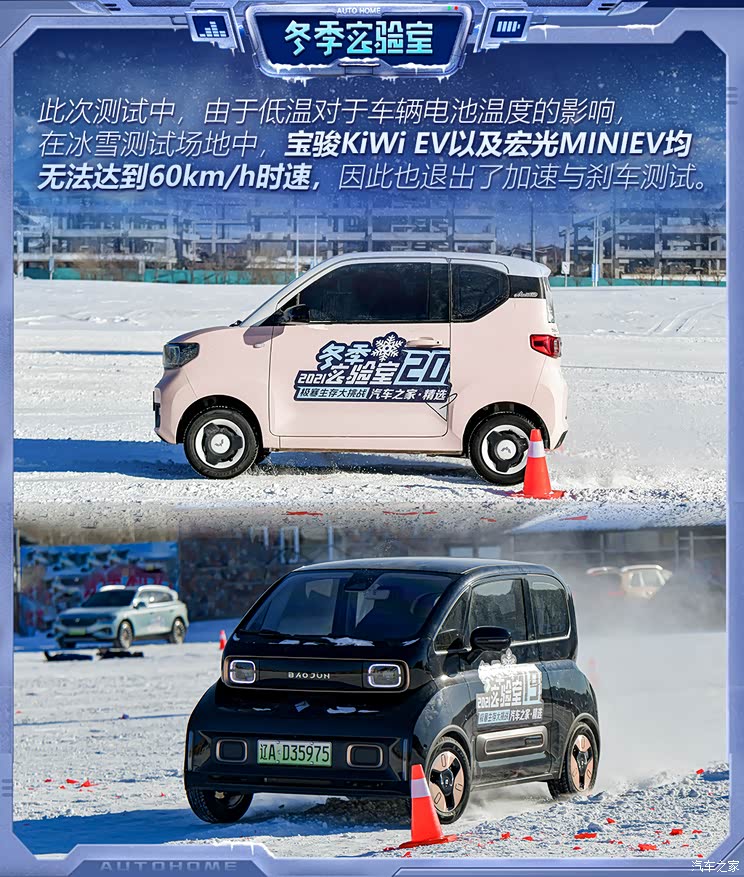
In the power system, we also found that the SOC of the power battery will seriously affect the acceleration performance. In a low temperature environment, when the vehicle accelerates continuously, the reduction of power will also have a significant performance impact. Among them, Baojun KiWi EV and Hongguang MINIEV were unable to complete the 0-60km/h acceleration test due to their relatively poor power, coupled with the impact of low temperature and SOC power on power, and eventually withdrew from the test.
● AEB active safety braking capability is greatly reduced
In the AEB active safety test, the test results actually demonstrate the lower limit of active braking on ice and snow roads. As the saying goes, ground adhesion determines all the dynamic performance of the car, and no adhesion is empty talk. On snow-covered roads, we also measured very convincing results. Most models with AEB function can only brake effectively at a speed of 20km/h or less, and their performance is very unstable. The best Mercedes-Benz EQS also passed the anti-rear-end collision test of only 25km/h.
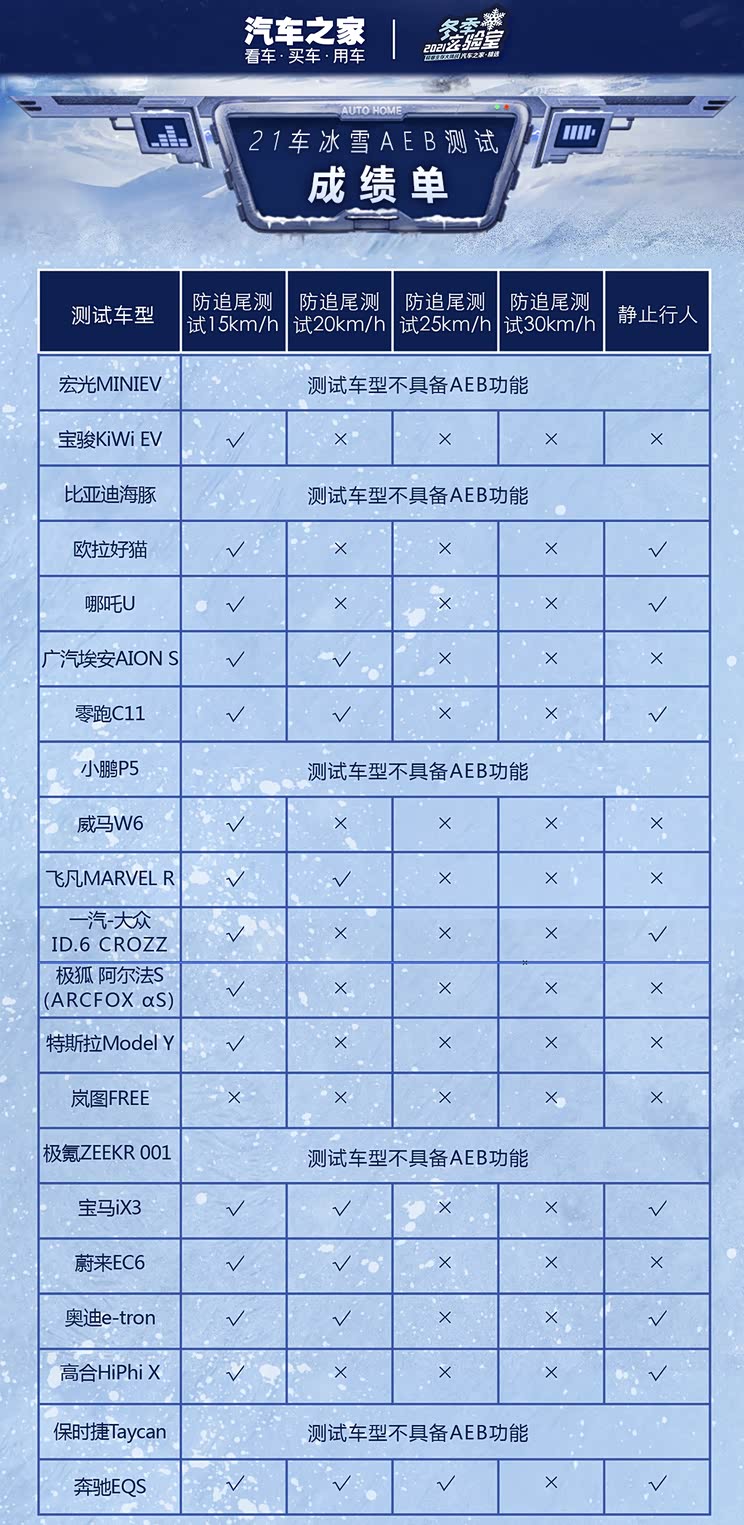
In addition, we also found that in addition to the greatly reduced active safety braking effect, the prompts and braking interventions of individual vehicles also showed delays or even failures. For example, LANTU FREE, anti-rear-end collision and static dummy tests all failed, while Tesla Model Y, Extreme Fox α coefficient S, WM W6 and Baojun KiWi EV only passed the 15km/h anti-rear-end collision test.
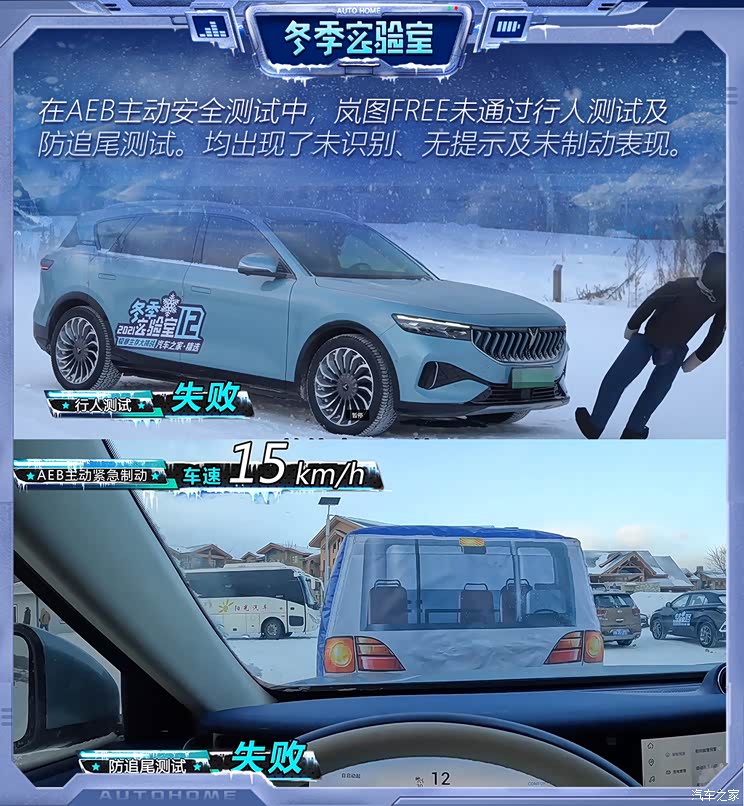
● Summary
At the same time, because of the real-time changes in the ice and snow road, we cannot accurately and stably predict the acceleration and braking performance of the vehicle like the dry land. The conclusion reminds us again that when driving on the ice and snow road, we must carefully control the overtaking timing of the vehicle (even not overtaking), and more safely anticipate the braking distance. Even speaking, we can hardly continue to copy the driving experience on the dry road to deal with the situation on the ice and snow road, so focusing on slow driving will be the first prerequisite for safe driving.
● 2021冬季实验室总结
经过5天120小时,2021汽车之家冬季实验室完成了全部3大板块15项测试。而本篇文章也将是本季冬季实验室的最后一篇内容。事实上,在今年我们不但挑战了前往更寒冷的东北地区,也通过21款热门车型的规模性测试获得了更多有价值的数据,以及通过真实的场景测试,希望对每一个新能源汽车用户、准用户在选车和用车上起到帮助。最后,我们也梳理21款车型在所有测试中的优缺点,您可以通过下方表格快速查看这些热门产品。并且,我们也在总结了8条干货建议,为此次冬季实验室做一次“浓缩才是精华”的收尾。我们明年再见~(数据/汽车之家 冬季实验室测试团队;文/汽车之家 姜田双、孙一超、尤冬青、侯明浩 图/汽车之家 胡永彬)
(1)北方地区用户,依然建议选车时将高续航作为购车的第一要素。
(2)电动车冬季出行半径建议按照官方续航的60%规划。并预留至少20%的电量进行补能。
(3)不建议冬季在电量低于15%以下过夜,除了续航会蒸发外,冷车充电效率也会更低。
(4)在可选条件下,优先选择120kW公共充电桩。
(5)建议您在冬季正常使用暖风空调,相比续航而言,舒适也许更重要。
(6)如果您的爱车有远程App服务,请一定记得使用。大幅提升用车体验和便利性。
(7)如果您要前往有冰雪路面的地区,请一定要提前更换雪胎。
(8)冰雪路面情况多变,慢行的同时避免急加急减速,主动安全一定不如我们紧握方向盘。
● 21款车型三大测试板块优缺点纵览
